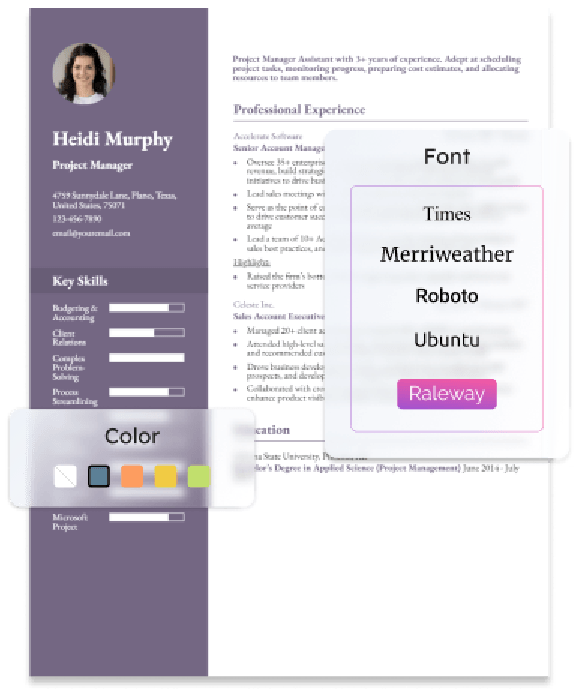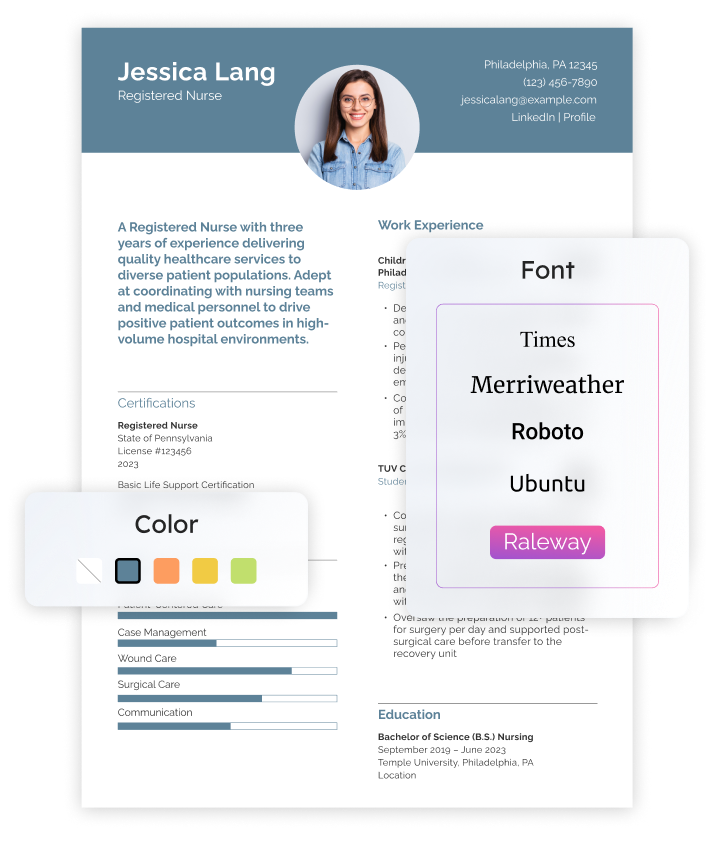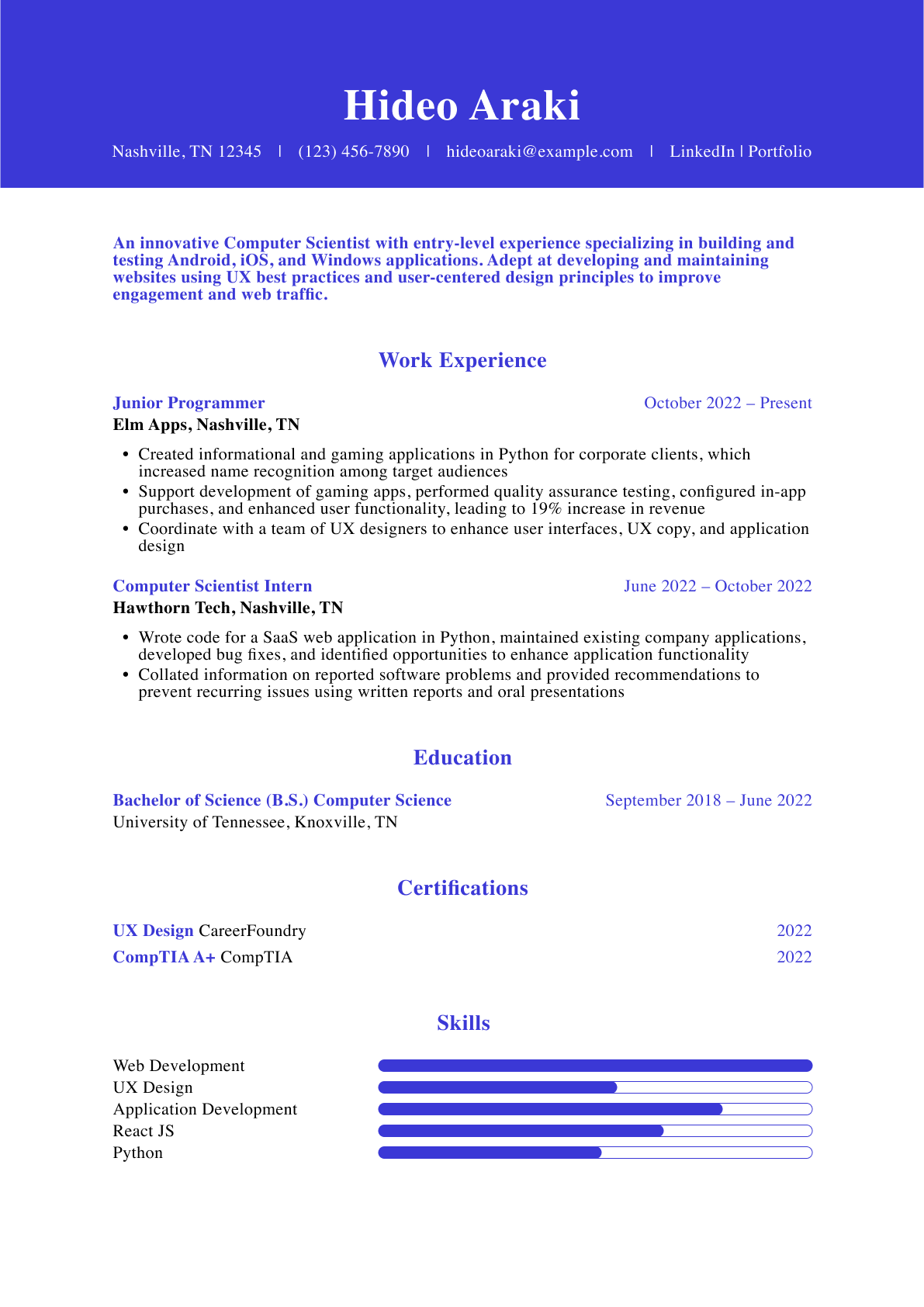If you seek a role as a web designer, the most effective way to market yourself to hiring managers is to provide specific examples of how you have designed and constructed successful websites throughout your career. Show your skills in front-end development, graphic design, and collaborating across teams. Quantifying the websites’ success using concrete numbers and metrics to demonstrate your expertise as a web designer to prospective employers is beneficial.
Most Popular Web Designer Resumes
Entry-Level Web Designer Resume
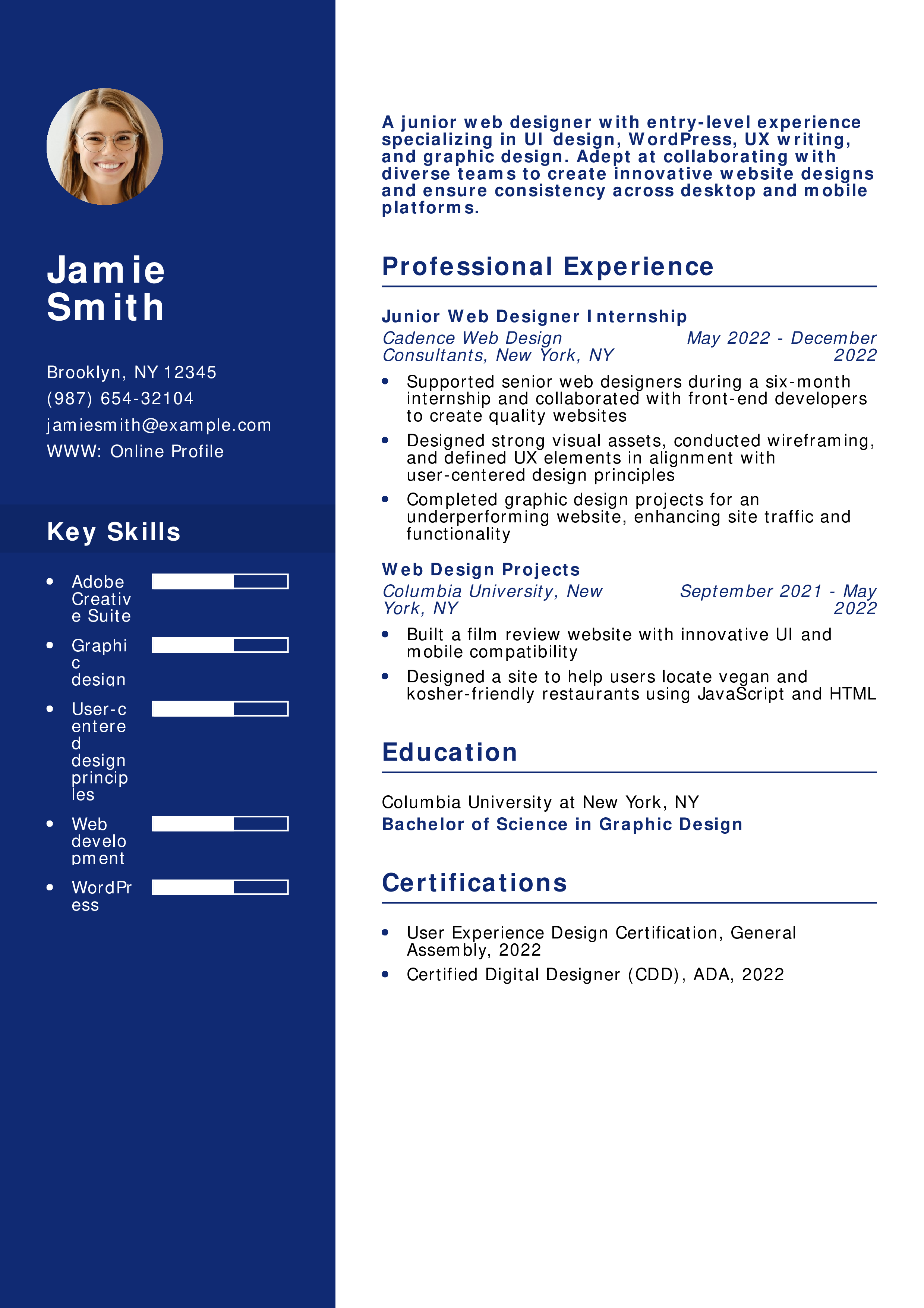
Why this resume is strong:
This resume features practical academic projects, a structured internship experience, and certifications to bolster entry-level skills. It’s concise yet impactful, focusing on relevant expertise while demonstrating results. For guidance, check out this article on how to list certifications on your resume.
Mid-Career Web Designer Resume
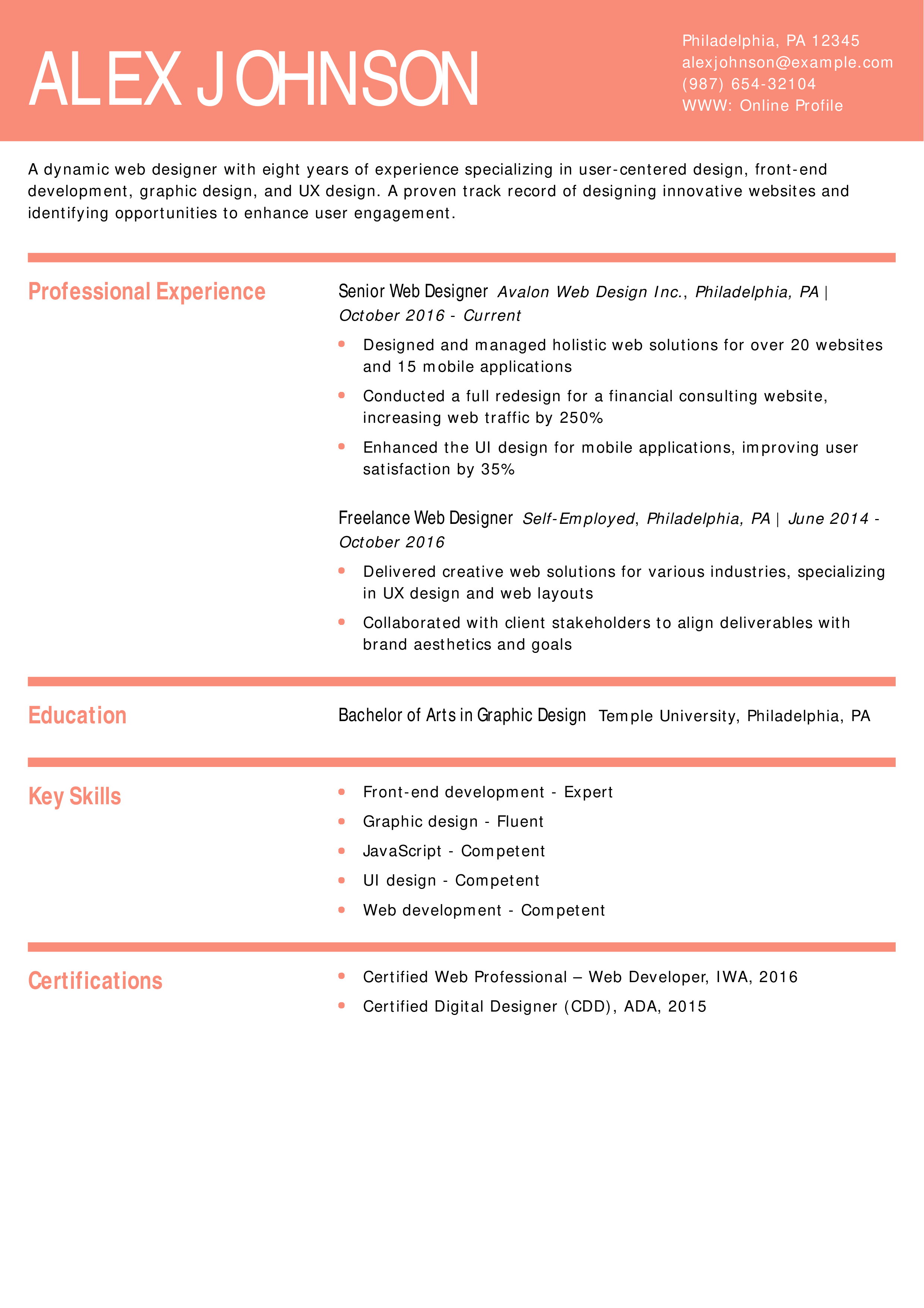
Why this resume is strong:
This resume showcases an established career with measurable impacts, such as improving web traffic and user satisfaction. It balances technical skills with collaborative achievements. Learn more about optimizing your resume layout in this guide on the best resume formats.
Senior Web Designer Resume
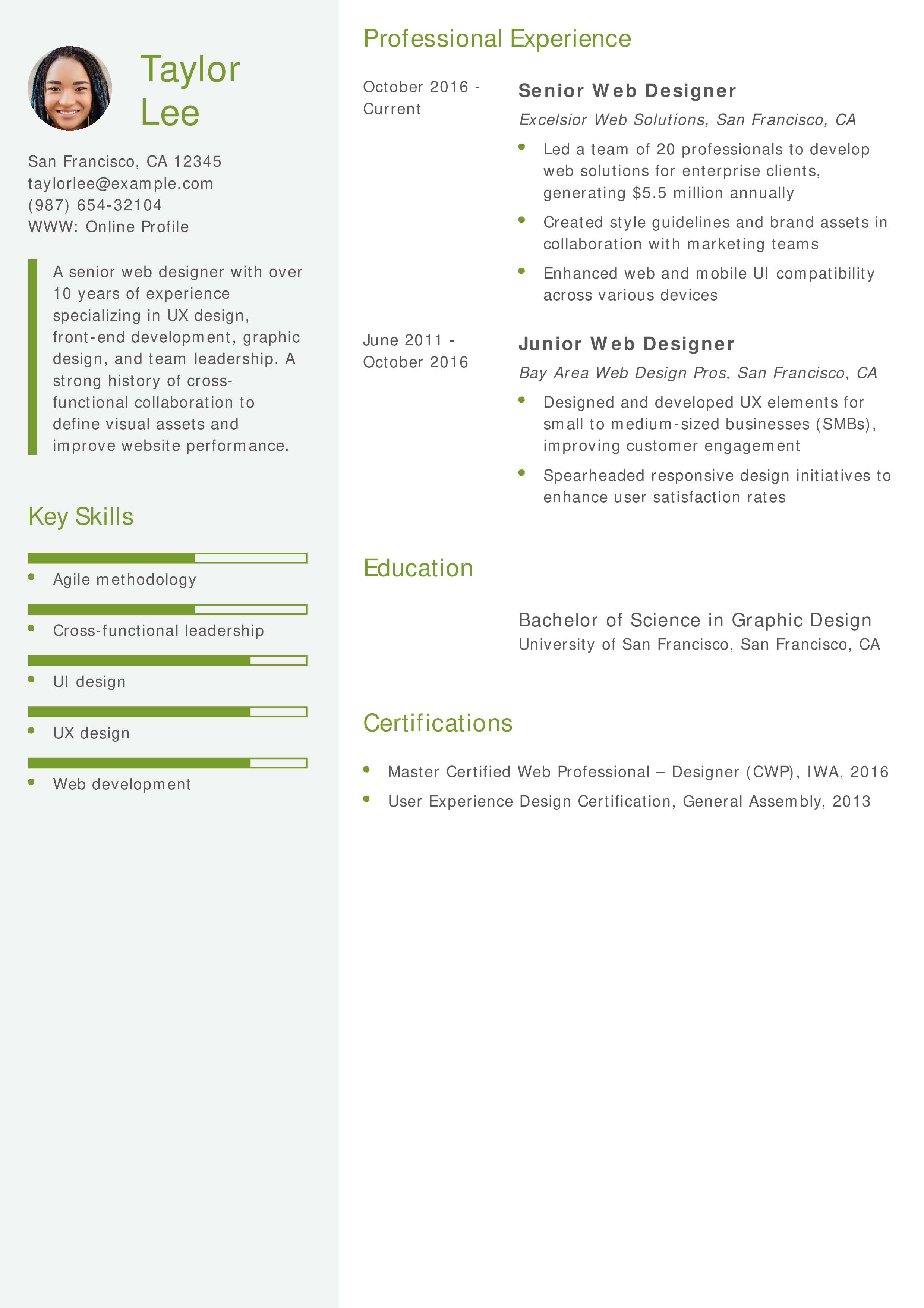
Why this resume is strong:
This resume demonstrates high-level leadership and measurable outcomes, focusing on client impact and revenue generation. It’s a stellar example of aligning content with career goals. For more layout strategies, check out this resume outline guide.
Mobile App Web Designer Resume
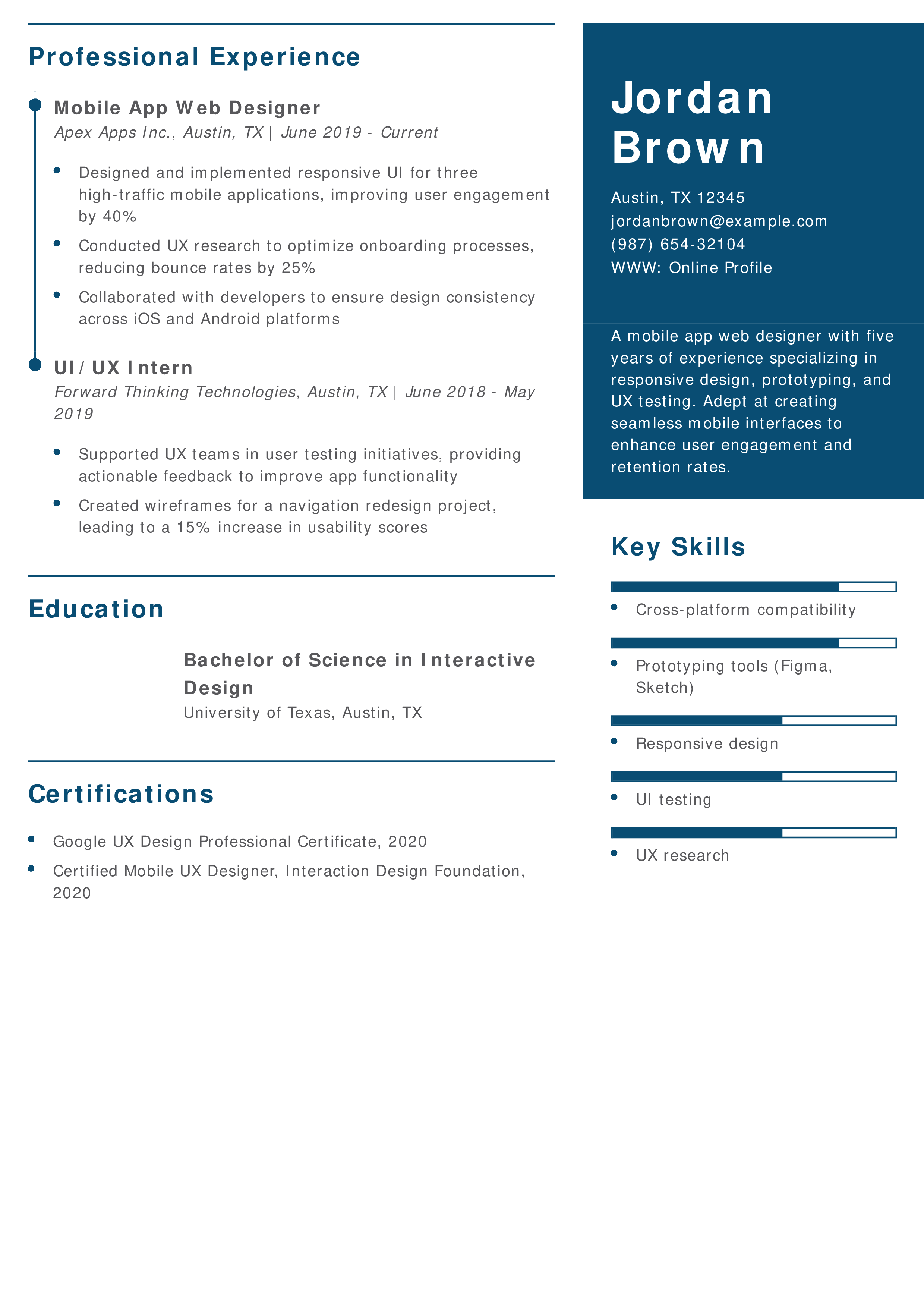
Why this resume is strong:
This resume highlights specialized skills for mobile platforms, backed by measurable results such as improving user engagement. It also demonstrates knowledge of cutting-edge tools. Learn more about emphasizing technical expertise in this article about technical skills for resumes.
E-commerce Web Designer Resume
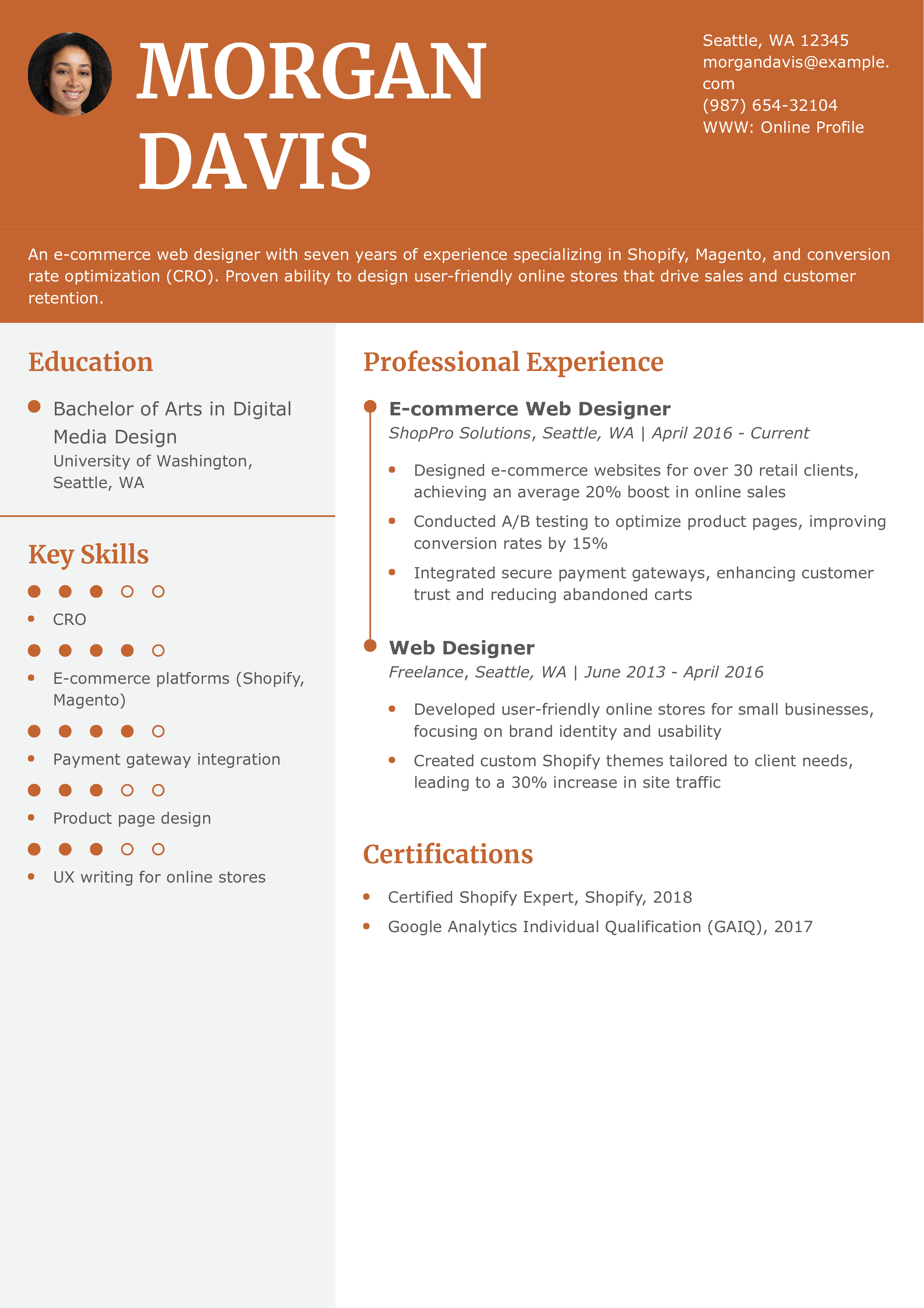
Why this resume is strong:
This resume is tailored to e-commerce, highlighting technical expertise in platforms like Shopify and Magento alongside measurable achievements in sales and conversion. For more tips on structuring e-commerce resumes, read what to put on your resume.
User Experience-Focused Web Designer Resume
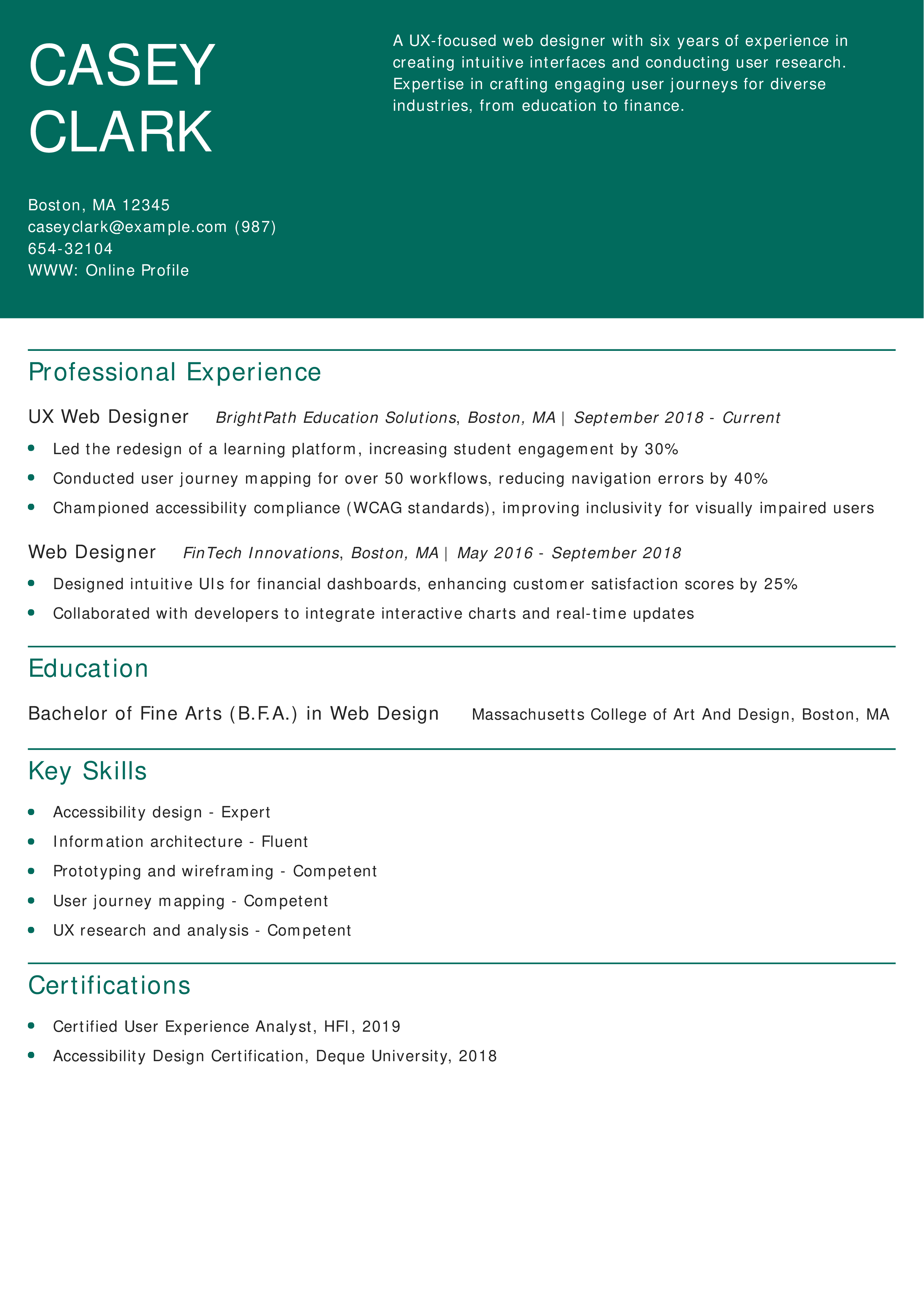
Why this resume is strong:
This resume emphasizes accessibility, user research, and data-backed interface improvements. The focus on UX principles reflects current industry priorities. For help building your own resume skills section, check out this skills guide.
Freelance Web Designer Resume
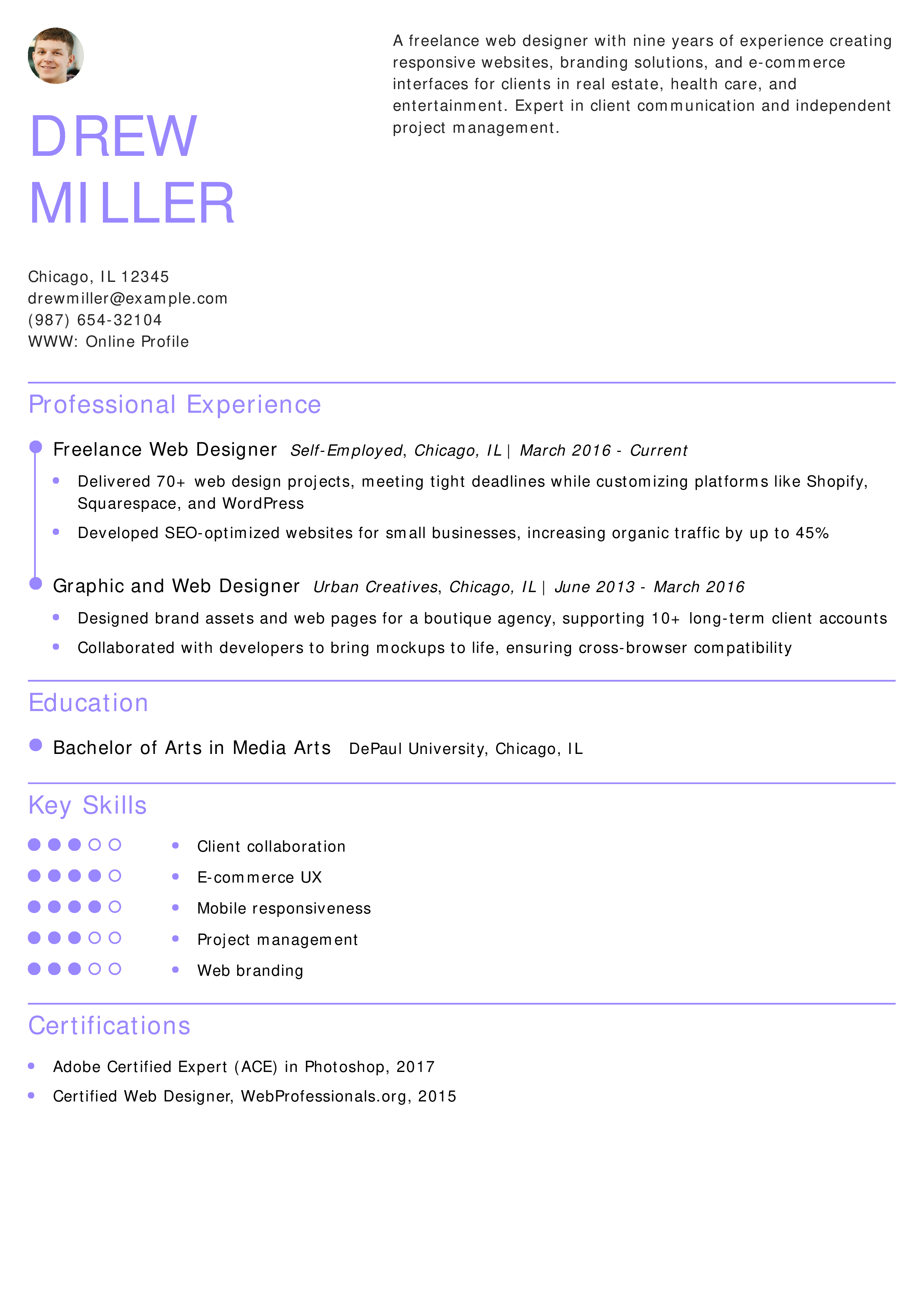
Why this resume is strong:
This resume showcases independence and flexibility through freelance work, plus quantifiable metrics to show success. For advice on structuring freelance or contract experience, visit this resume format guide.
Creative Web Designer Resume
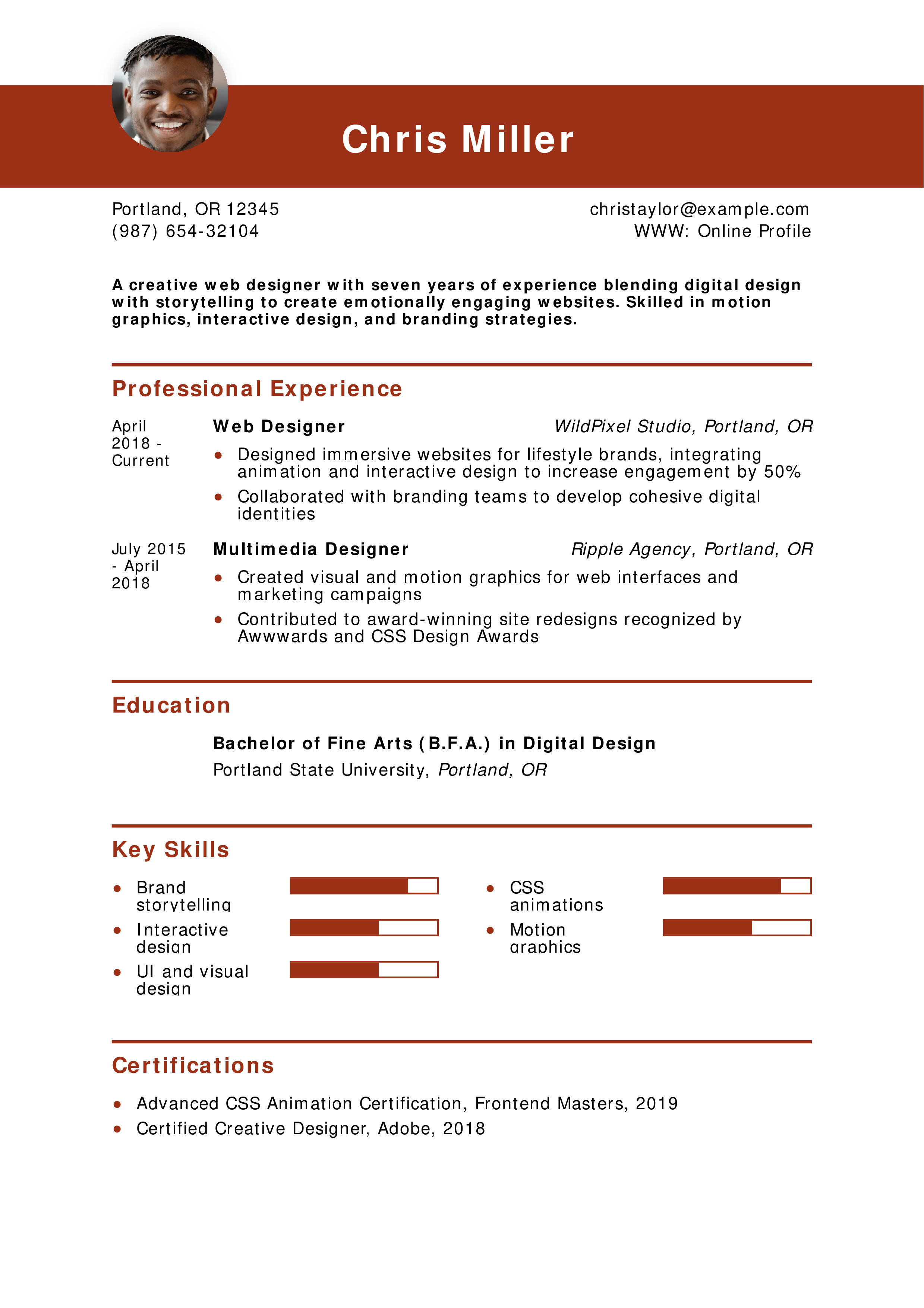
Why this resume is strong:
This resume communicates creativity while staying professional and structured. The focus on design impact and storytelling makes it engaging. To improve creative resume appeal, check out best fonts for resumes.
Junior Web Designer Resume
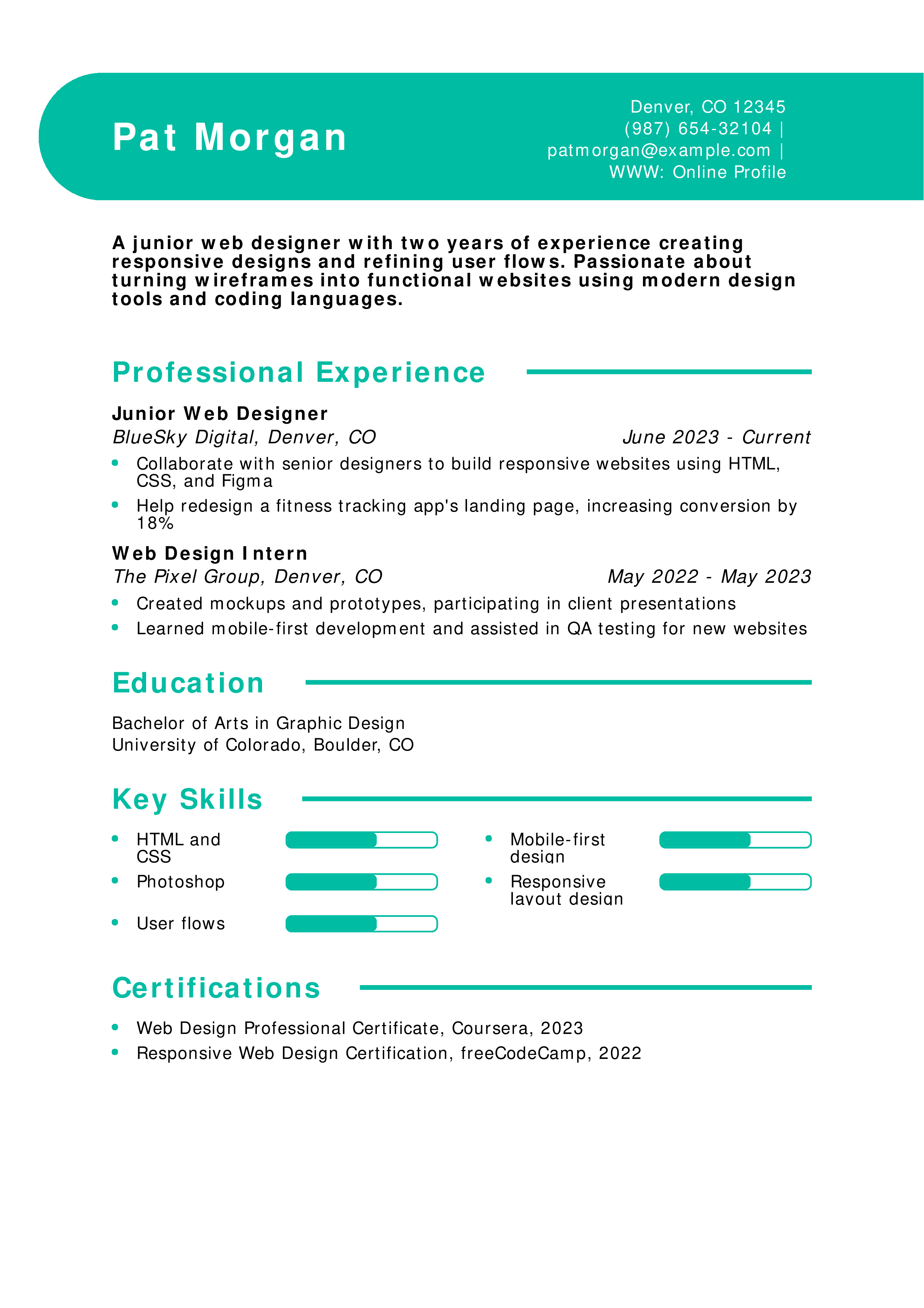
Why this resume is strong:
This resume presents a junior designer with tangible contributions and a strong learning curve. Academic and internship work flows well into current experience. To enhance your early-career resume, check out this article on resume summary examples.
White Space-Focused Web Designer Resume
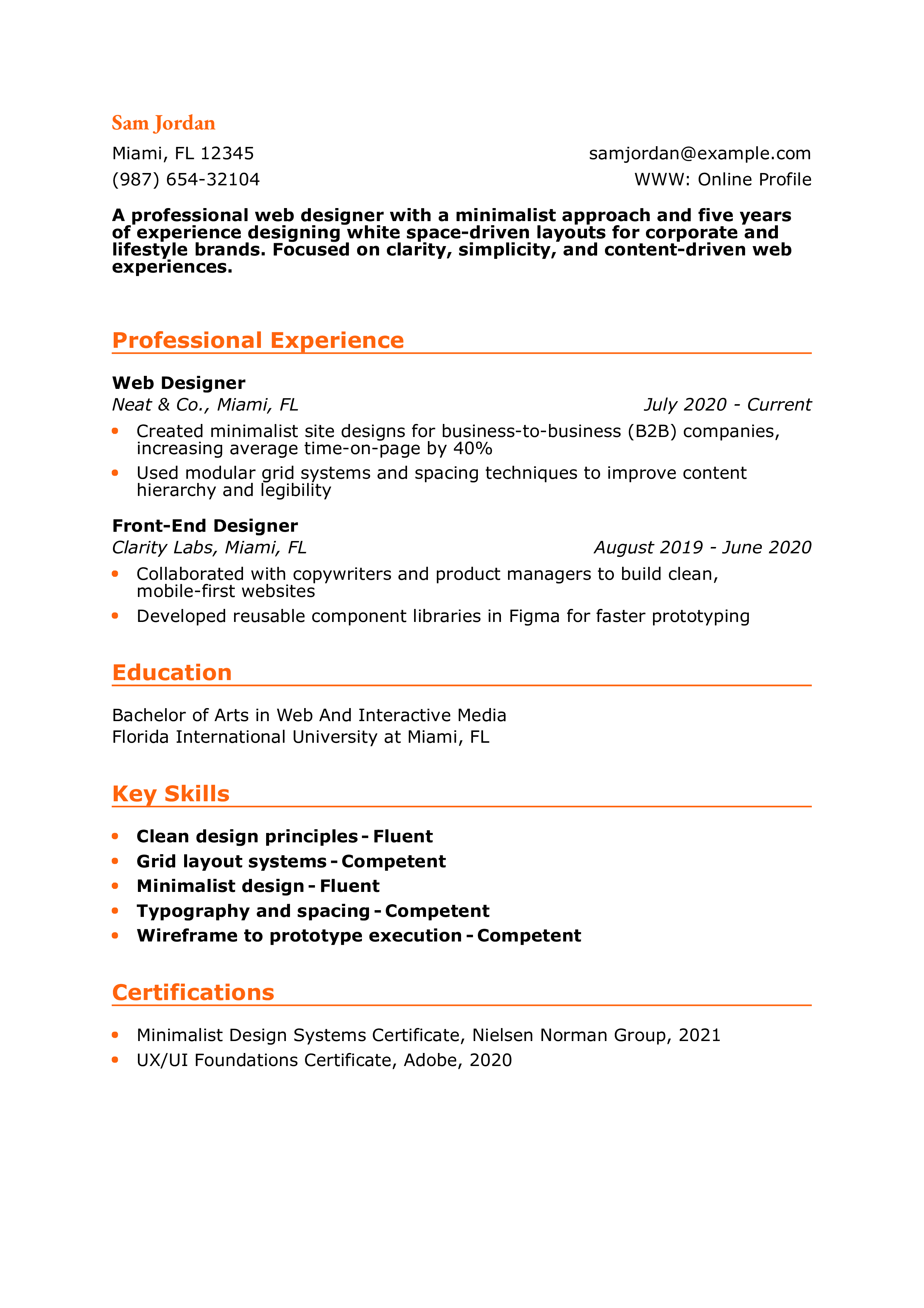
Why this resume is strong:
This resume reflects the designer’s personal style and values—simplicity, space, and usability — through language and content. To align your layout with design sensibility, explore this comparison of CVs and resumes.
Web Designer Fresher Resume
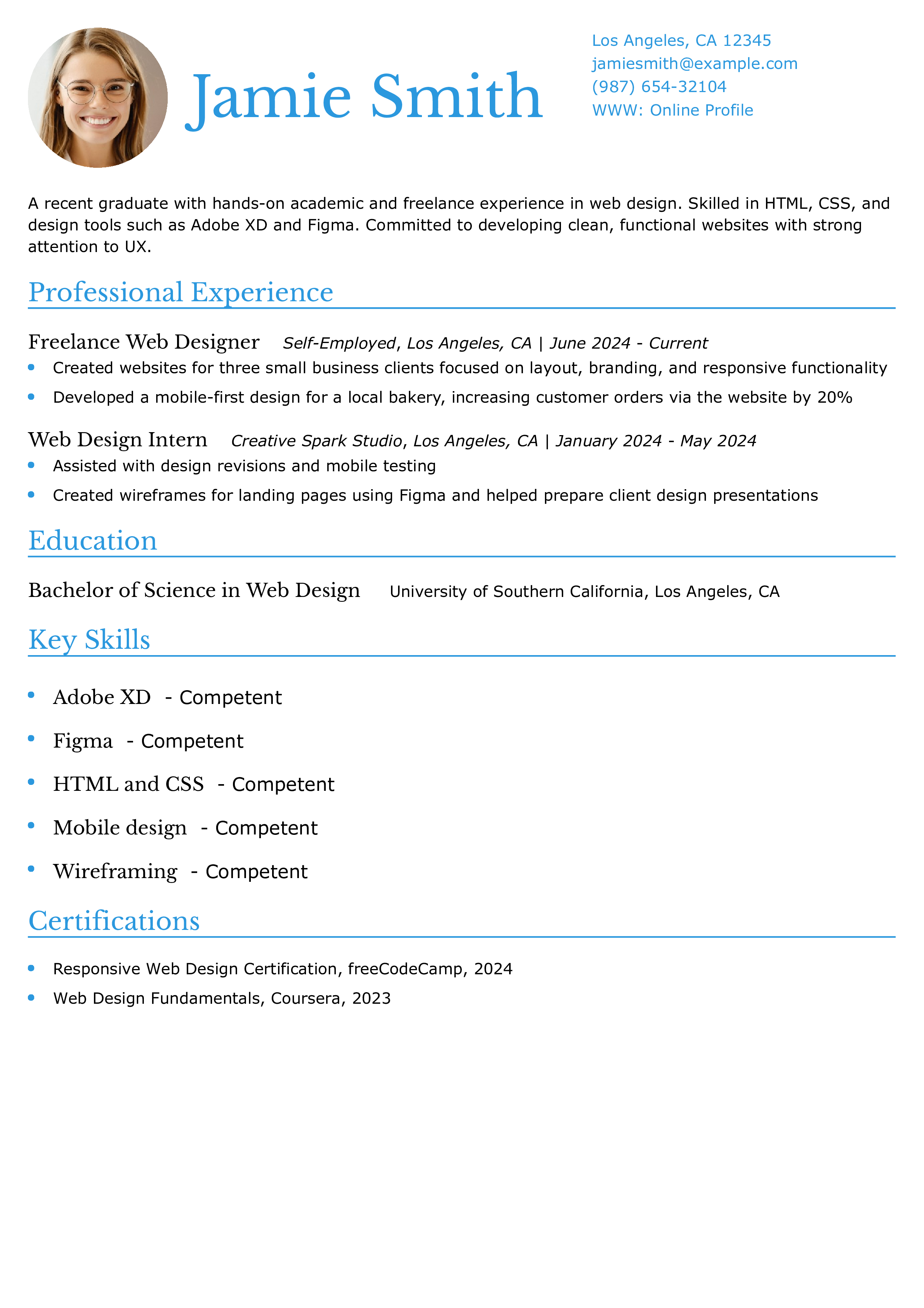
Why this resume is strong:
This resume shows how a fresher can turn freelance and internship experience into real results. It’s honest, practical, and focused on growth. Learn how to structure entry-level resumes in this guide for resume tips for new professionals.
Web Designer and Developer Resume
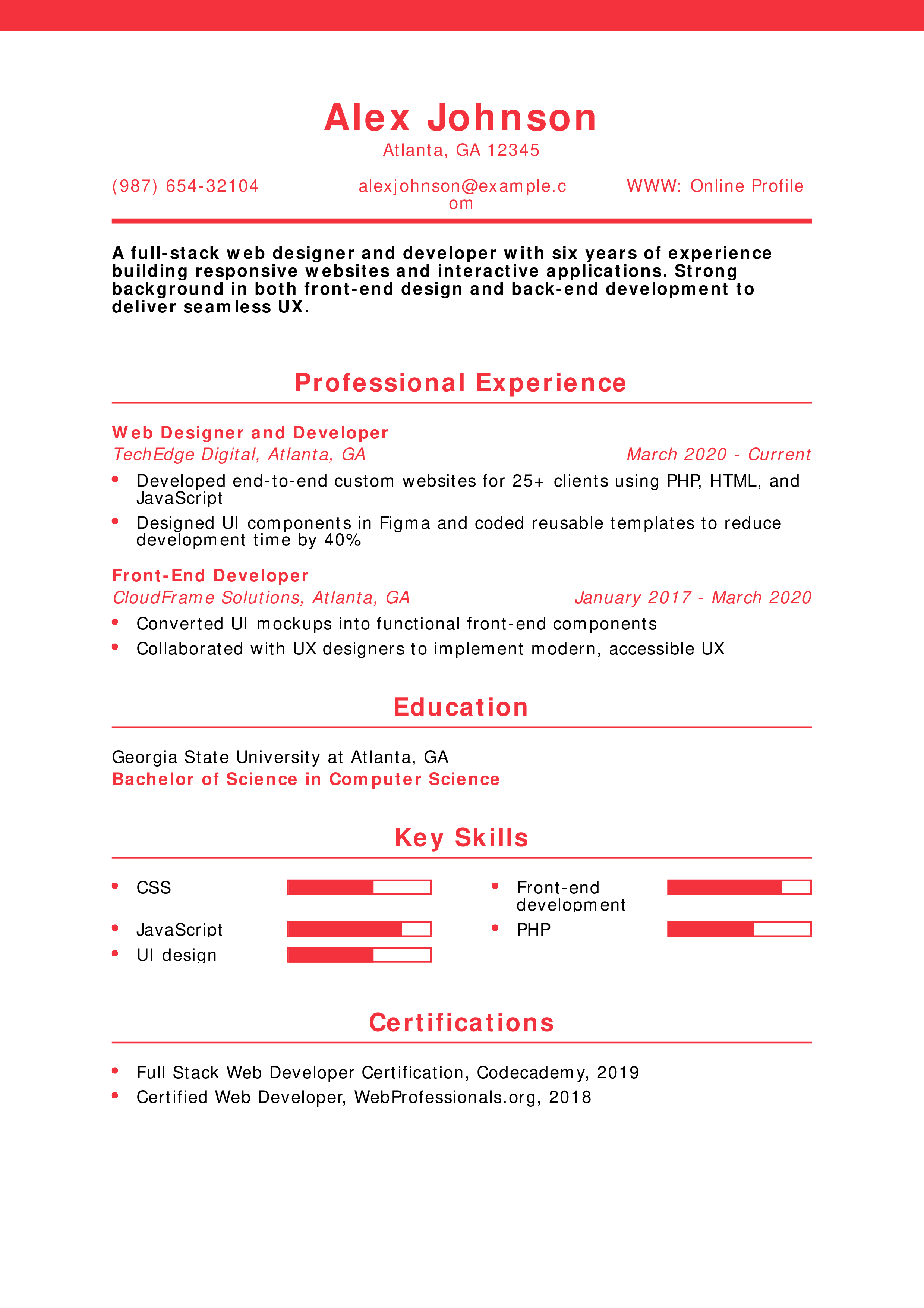
Why this resume is strong:
This resume bridges the gap between design and development, giving a well-rounded view of technical capability and design skill. For tips on combining multiple roles, explore what to put on your resume.
Responsive Web Designer Resume
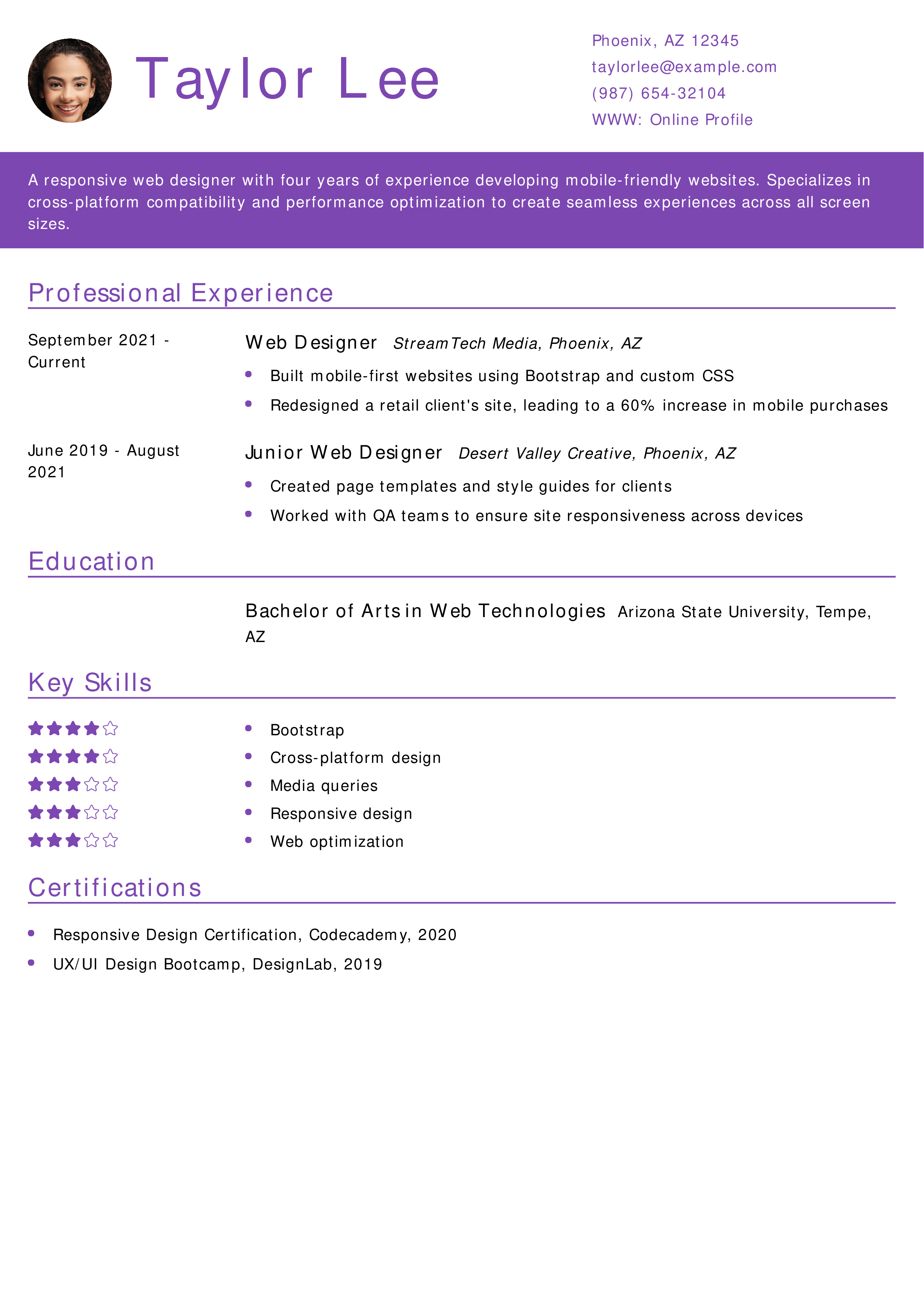
Why this resume is strong:
This resume focuses on the designer’s expertise in mobile and responsive layouts — essential skills in today’s web landscape. To learn more about responsive design relevance, read this article on resume layout tips.
Corporate Web Designer Resume
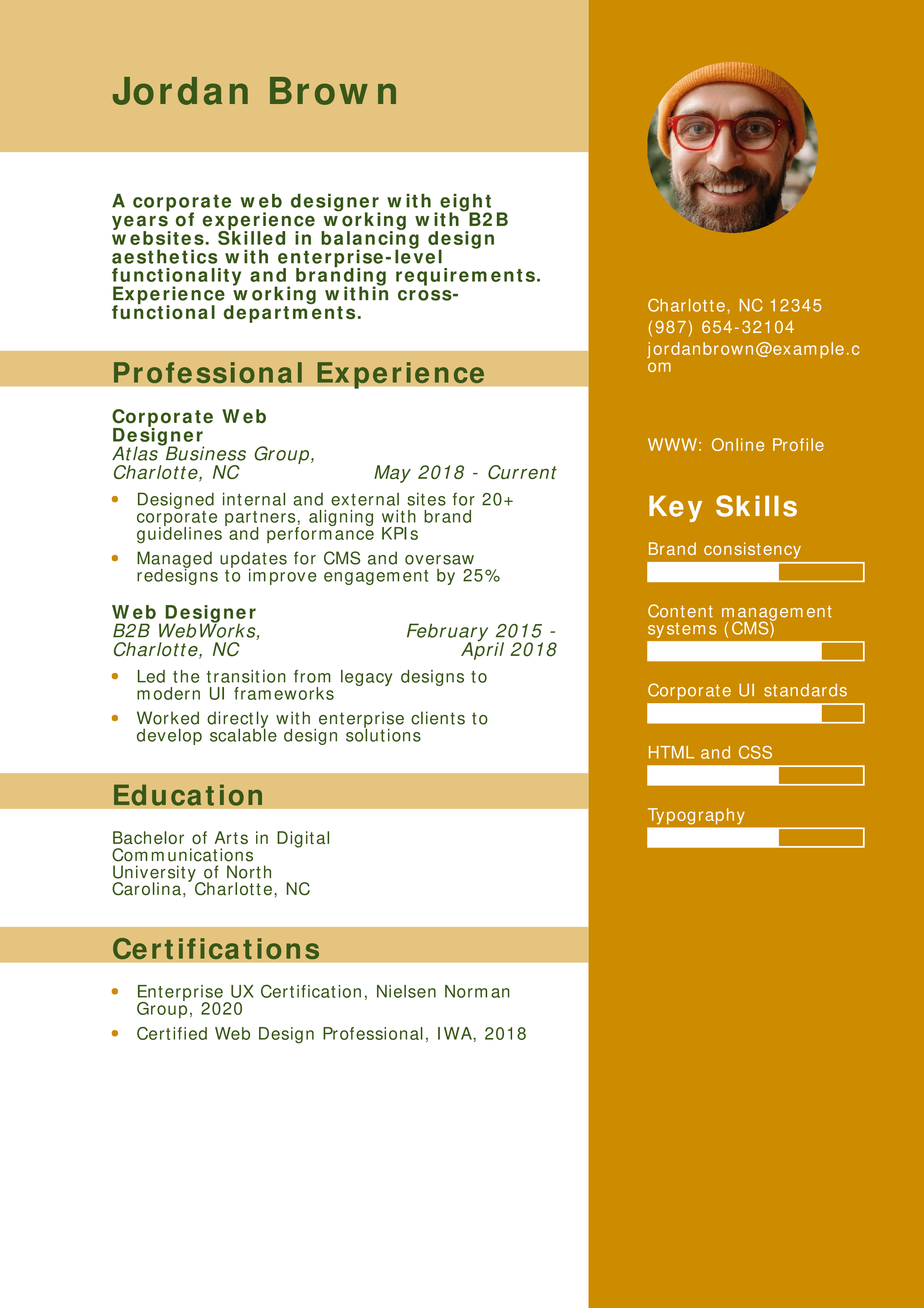
Why this resume is strong:
This resume speaks to a specific industry, corporate and enterprise web design, while still showing versatility and results. If you’re in a similar space, read more about resume formatting in this guide to one-page resumes.
User Experience/User Interface Hybrid Web Designer Resume
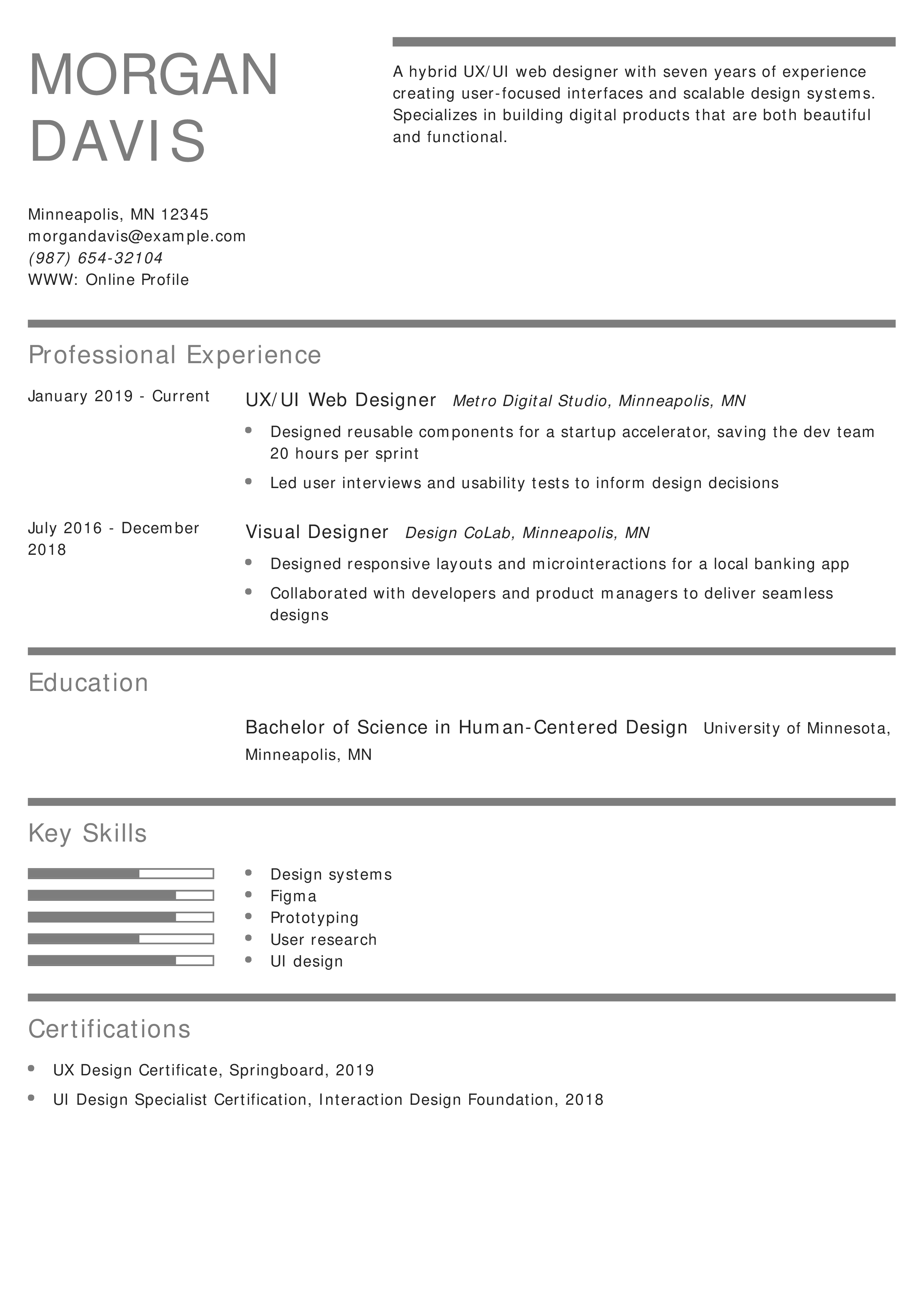
Why this resume is strong:
This resume effectively blends two skill areas — UX and UI — into one cohesive story. It communicates impact without overloading the reader. For tips on balancing multiple design roles, read this resume skills article.
Portfolio-Based Web Designer Resume
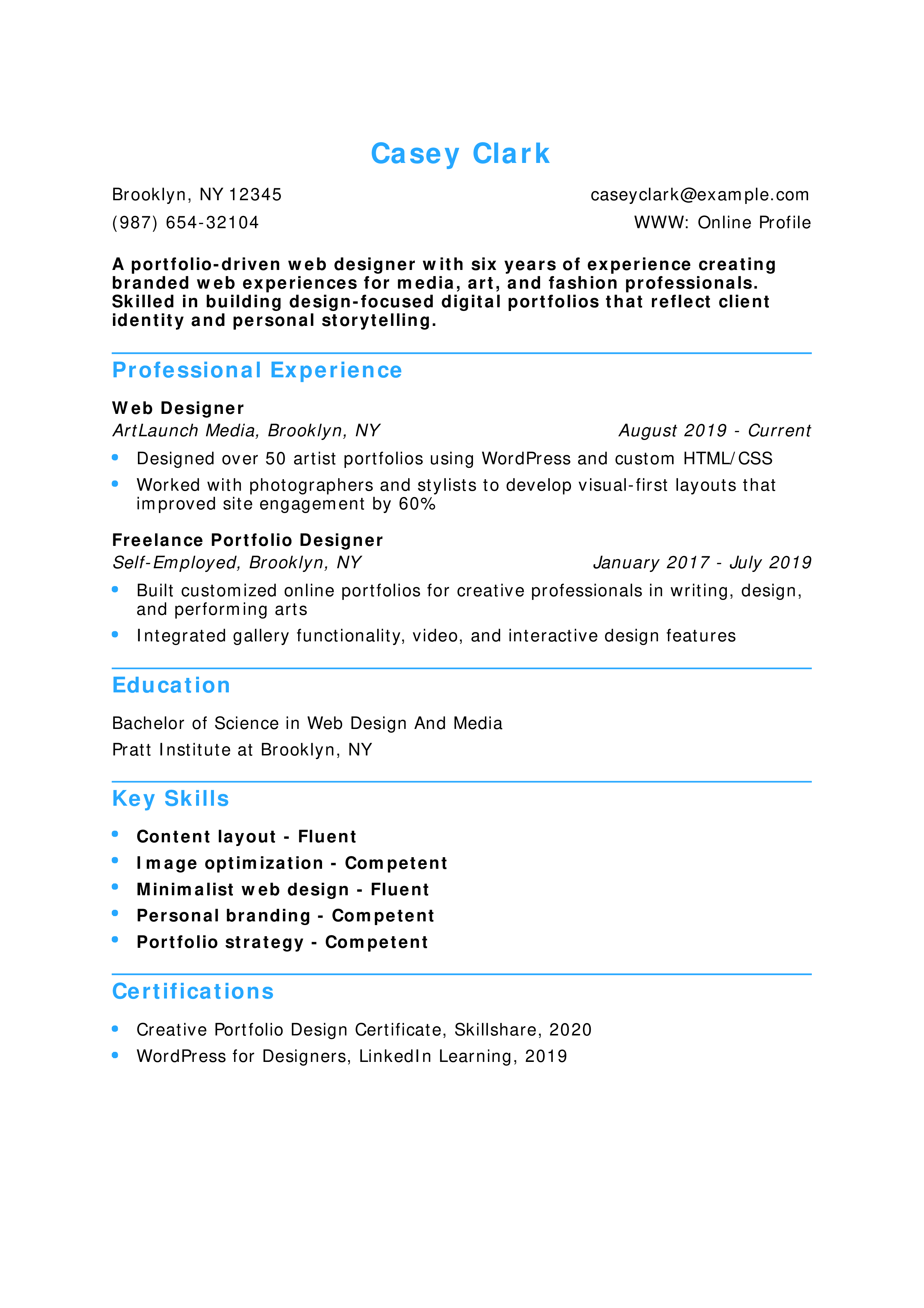
Why this resume is strong:
This resume showcases how to make portfolio design its specialty, highlighting work with creatives and measurable design outcomes. For more help with portfolio structure, see this resume interests section guide.
Conversion-Focused Web Designer Resume
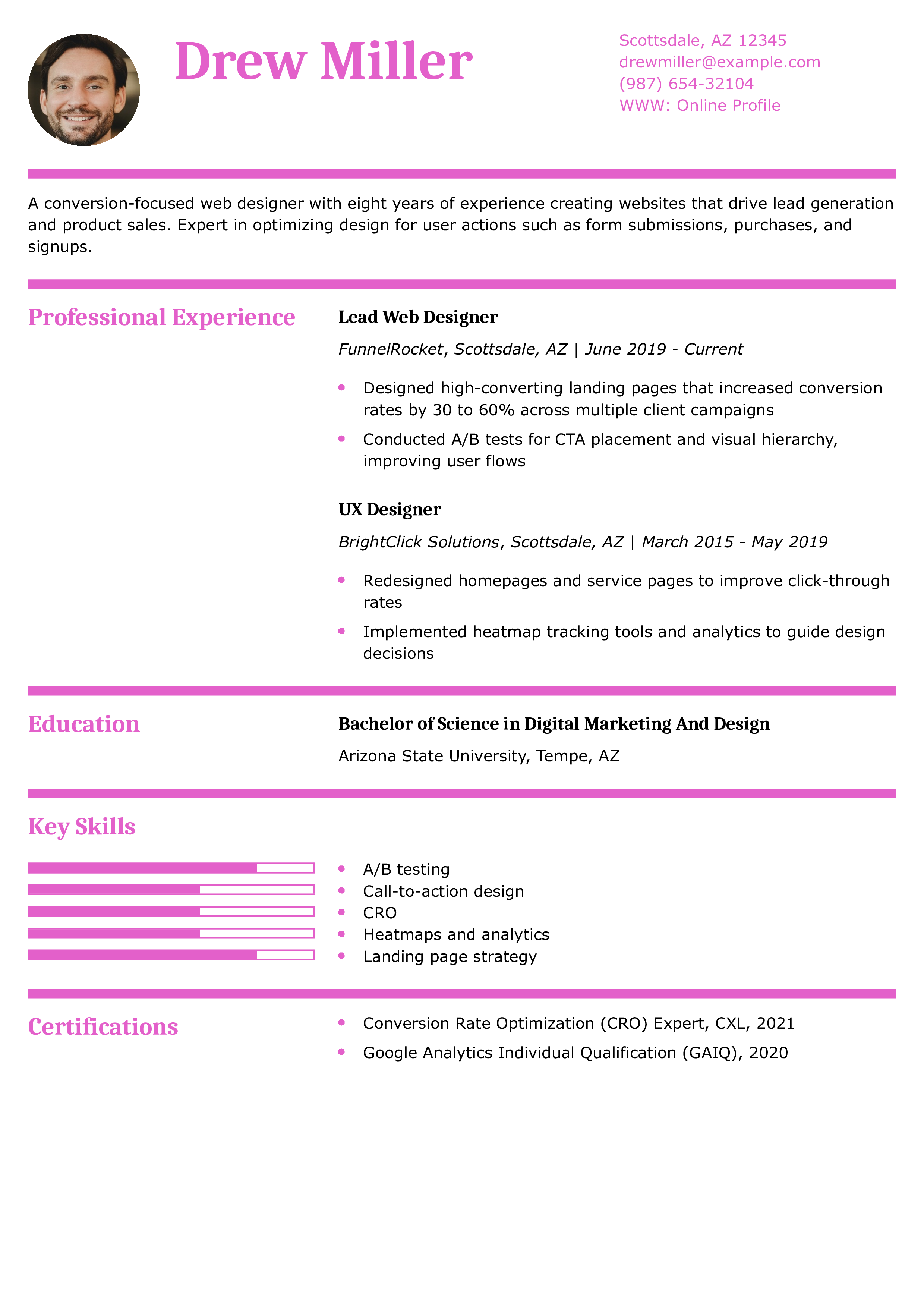
Why this resume is strong:
This resume targets business goals and shows how design impacts user behavior and sales. For more on quantifying resume achievements, check out how far back a resume should go.
Agency Web Designer Resume
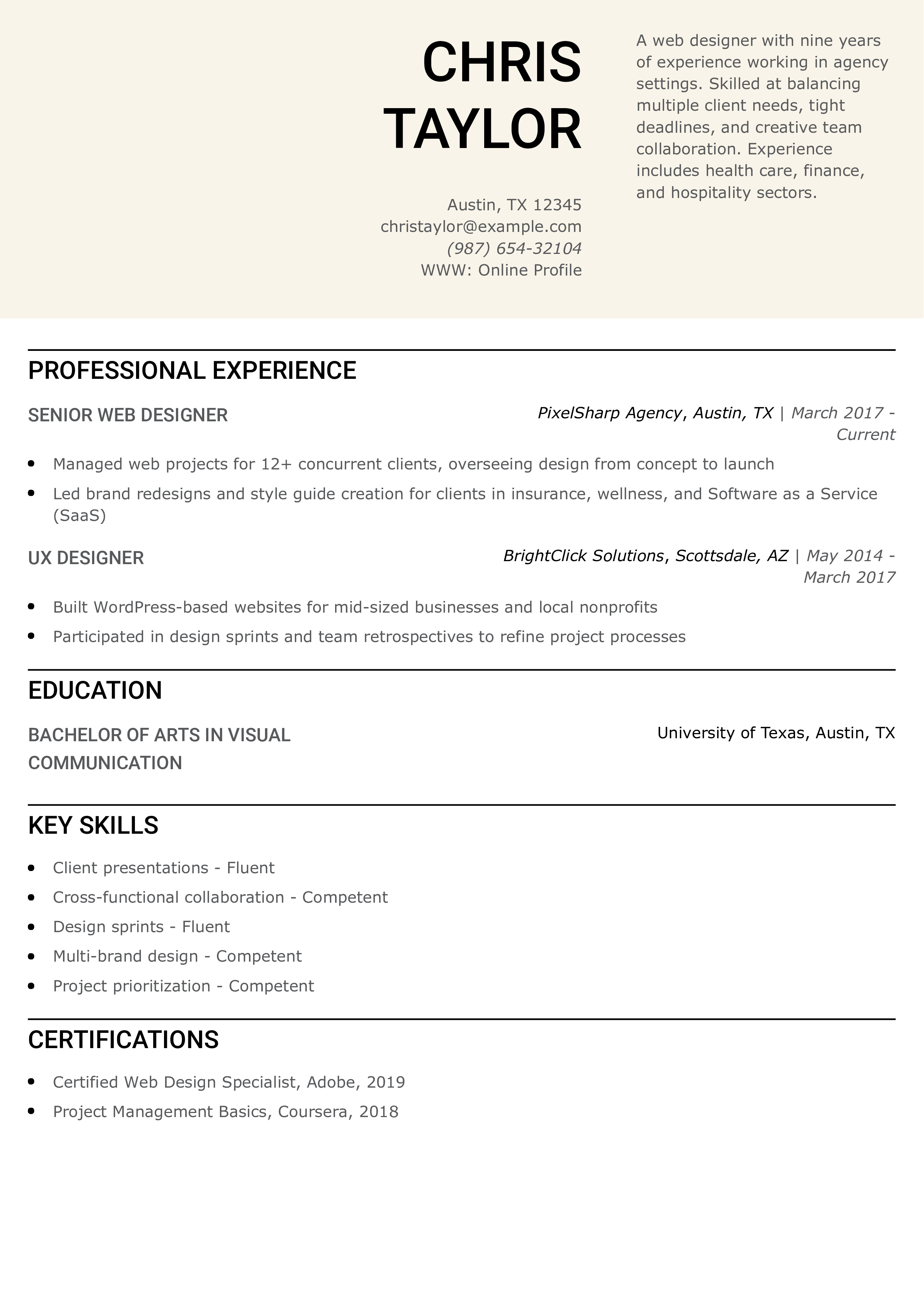
Why this resume is strong:
This resume speaks to the fast-paced agency environment and the designer’s ability to juggle multiple priorities. For more on how to tailor your experience to specific industries, check out this guide to aligning resumes with job descriptions.
Accessible Web Designer Resume
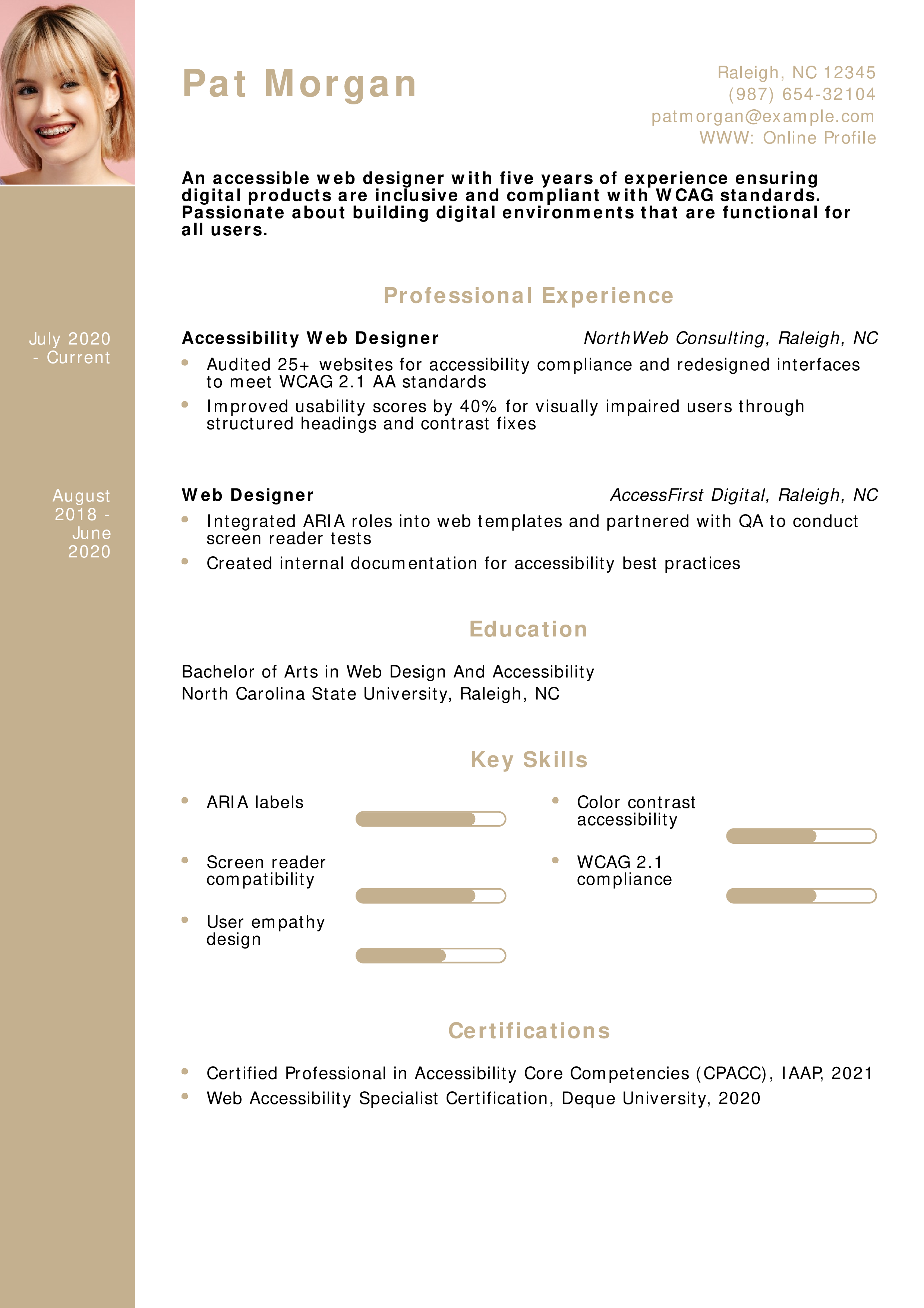
Why this resume is strong:
This resume directly addresses a key concern in modern design — accessibility — and presents clear actions and results. For more on adding certifications, check out how to list certifications.
User Experience Strategist and Web Designer Resume
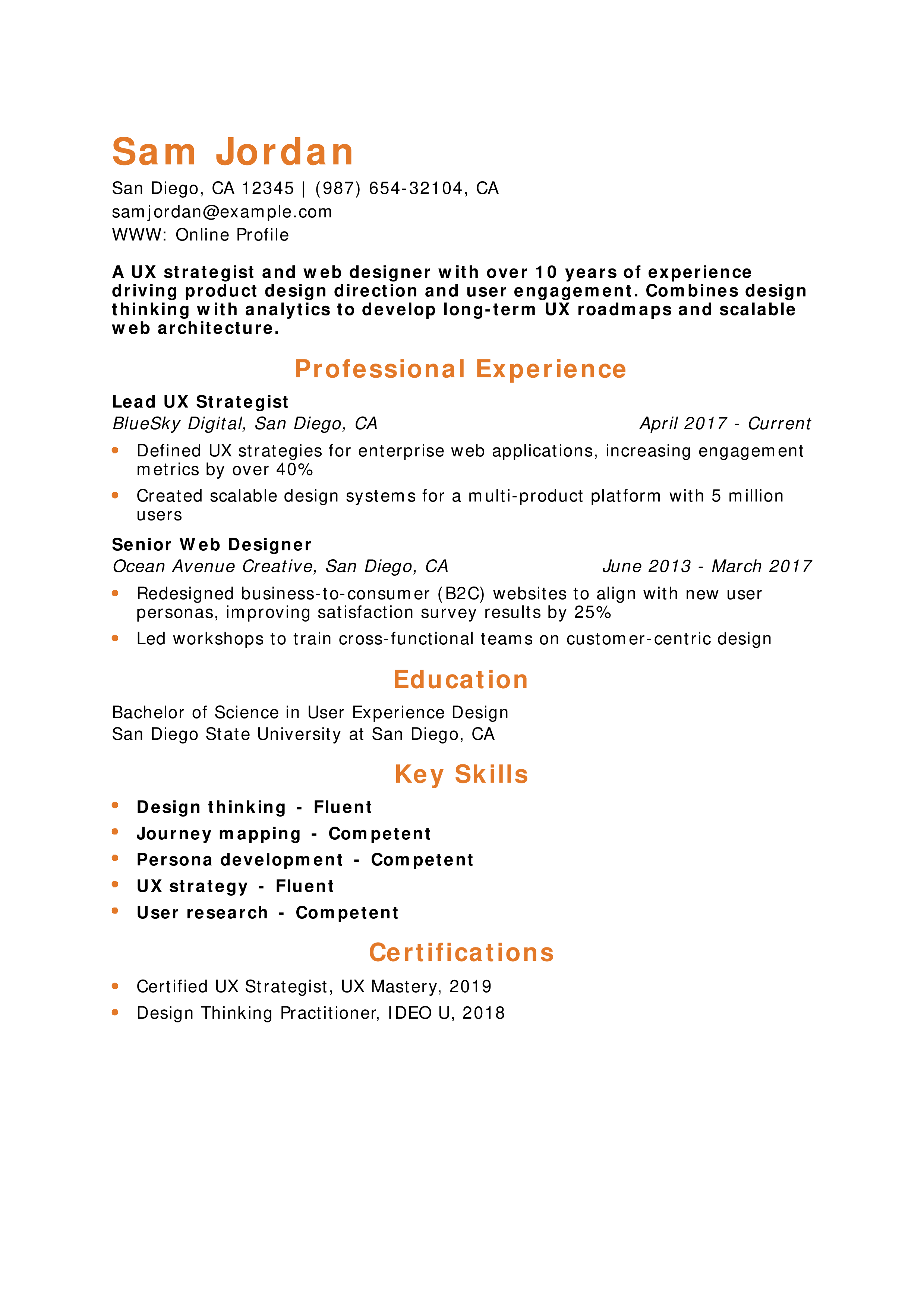
Why this resume is strong:
This resume is strategic, showing how UX and design decisions align with big-picture goals. To build a resume with clarity and purpose, review writing resume objectives.
Web Content Designer Resume
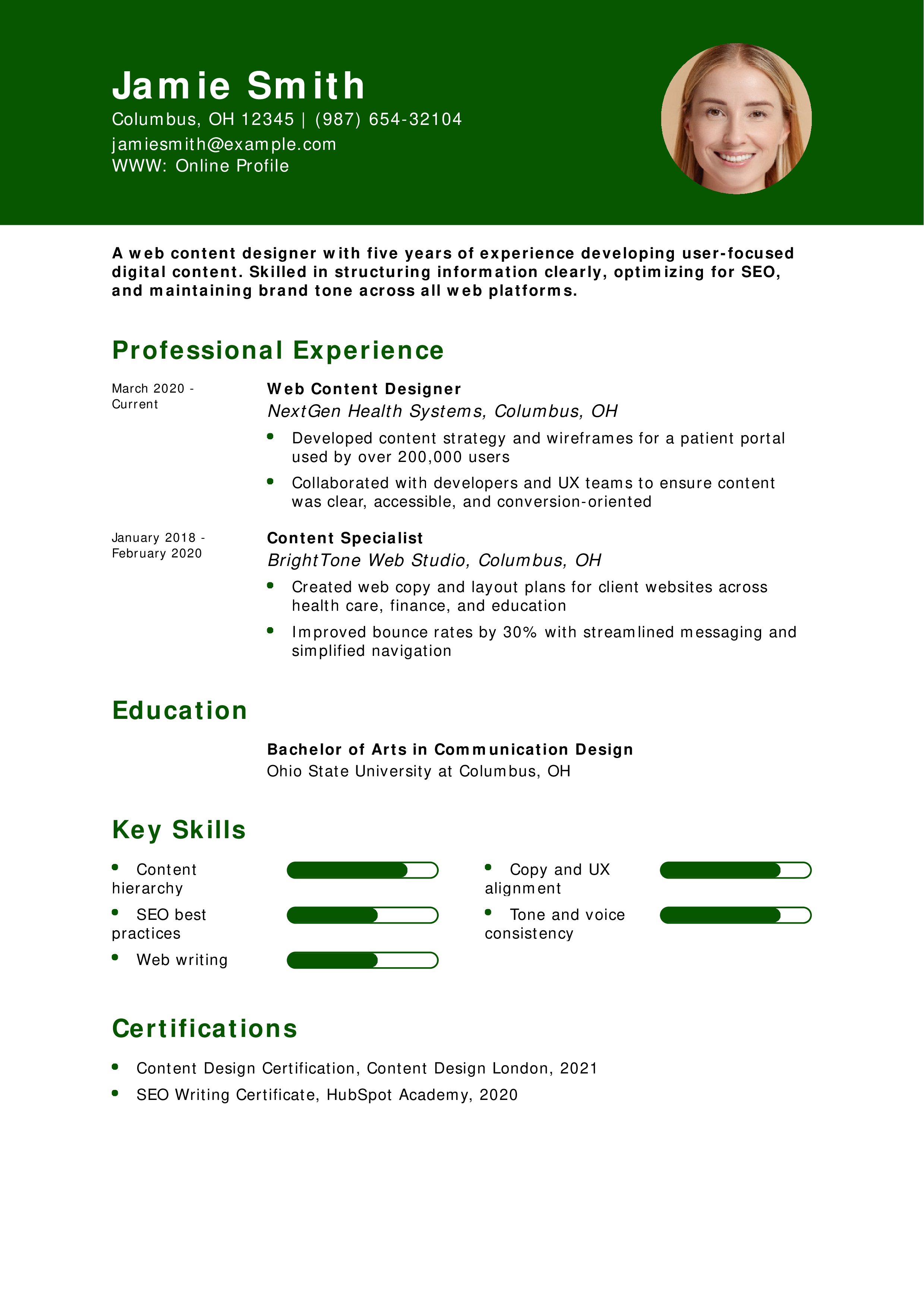
Why this resume is strong:
This resume focuses on writing as design, showing how well-structured content supports user needs and business outcomes. For more guidance on listing strong skills, read this article on resume language skills.
Landing Page Specialist Resume
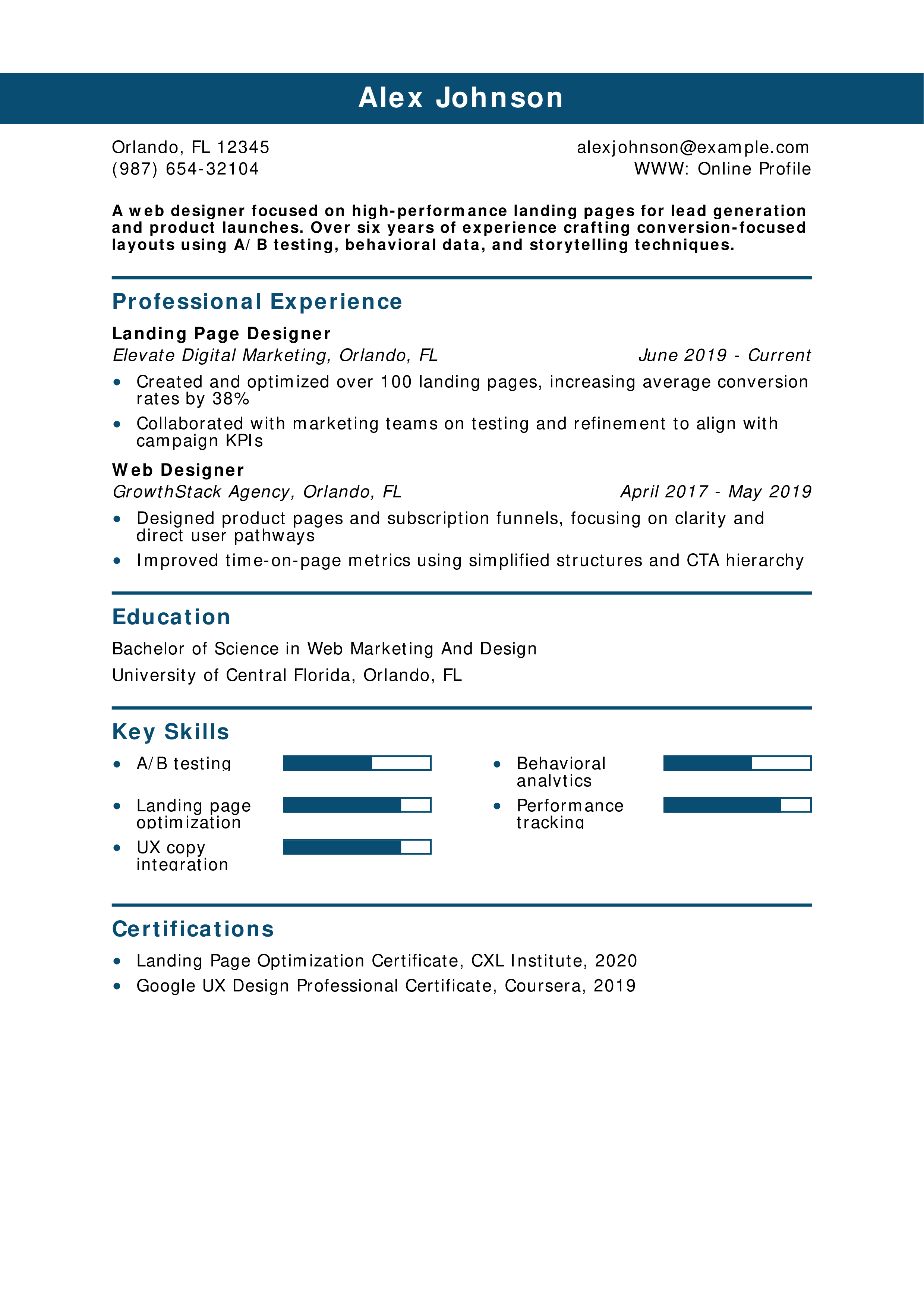
Why this resume is strong:
This resume delivers evidence of measurable success in conversion-focused design. It highlights specialization in a key growth area. Learn more about presenting metrics effectively in this guide to resume summaries.
Design System Web Designer Resume
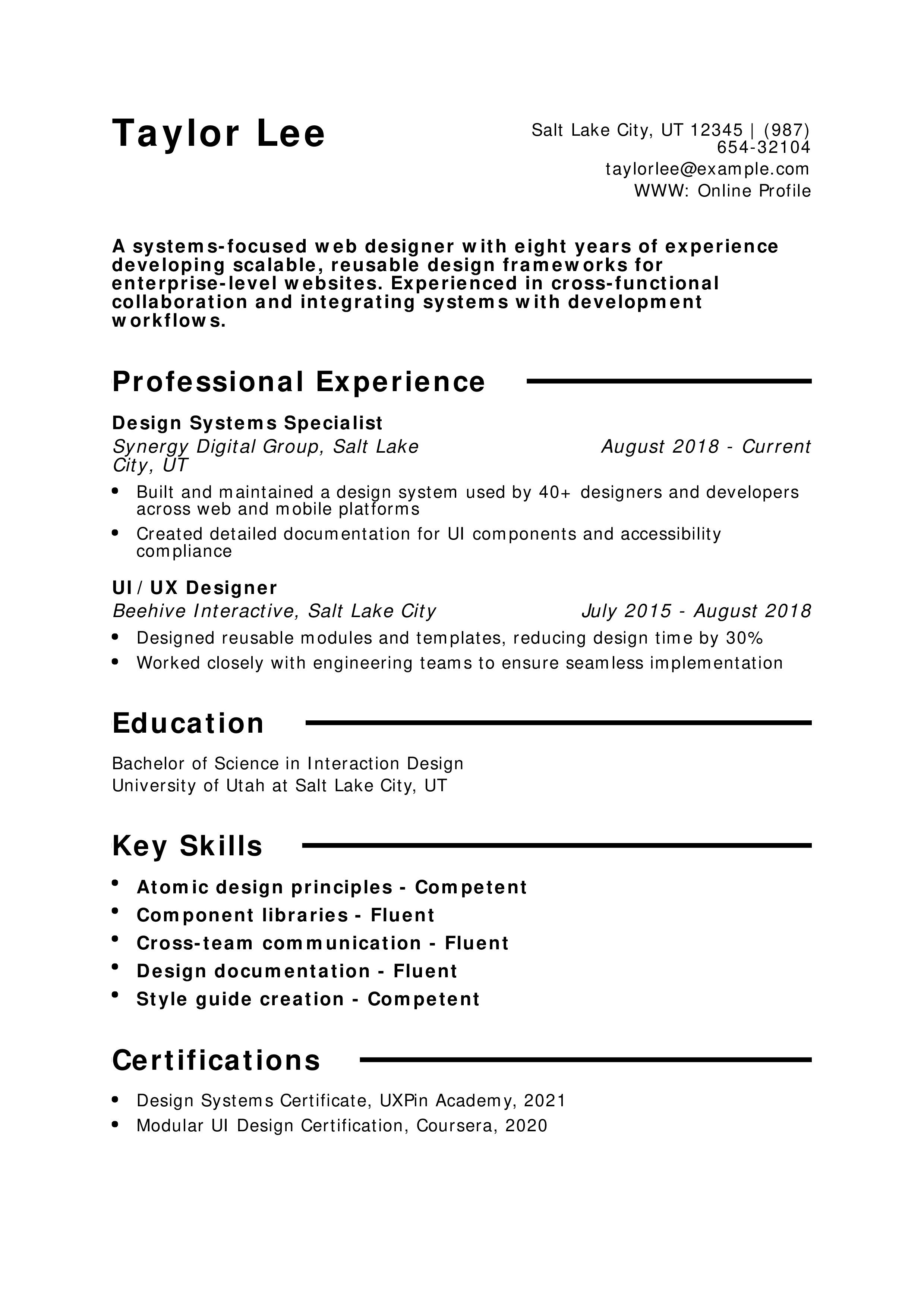
Why this resume is strong:
This resume focuses on efficiency and reusability, valuable assets for companies scaling products. For tips on aligning design and engineering efforts, check out this resource on resume technical skills.
Email and Marketing Web Designer Resume
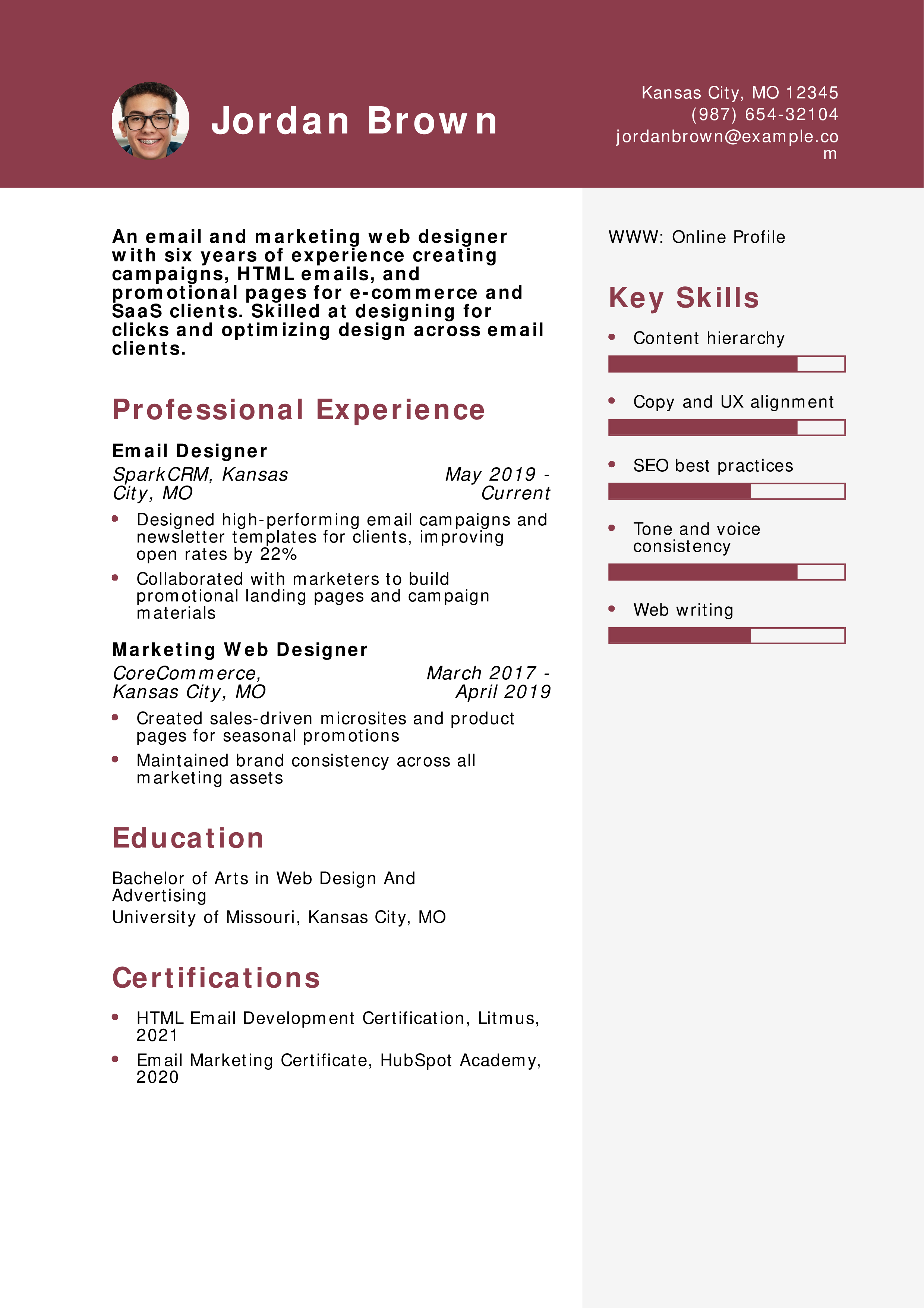
Why this resume is strong:
This resume clearly connects design and marketing results. It highlights technical know-how alongside user engagement. For more ways to structure campaign work, read what to include in a resume.
Web Accessibility Advocate Resume
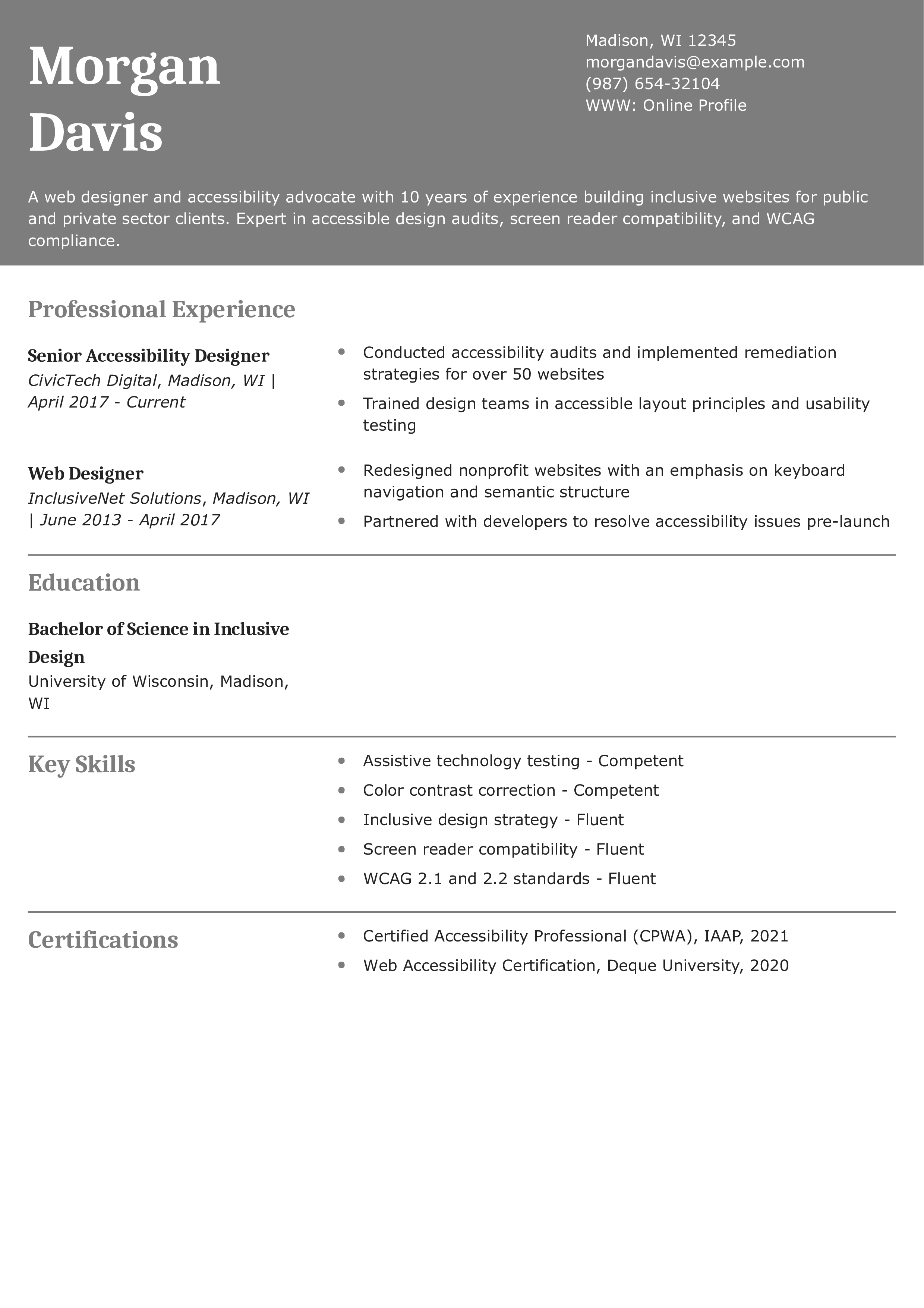
Why this resume is strong:
This resume focuses on a growing need in web design — ensuring inclusivity and legal compliance. It reflects advocacy, leadership, and technical skill. Learn more about formatting certifications and accessibility credentials in this guide to listing education on your resume.
Our templates are crafted by professional resume writers to make creating your resume quick, easy, and effective.
- Professional resume template downloads
- Customized cover letter generation
- AI resume writing support
- Career-building resources and advice
Web Designer Text-Only Resume Templates and Examples
How To Write a Web Designer Resume
1. Write a compelling profile summarizing your qualifications
Your professional profile is the first thing hiring managers read when evaluating your job application. To make a positive first impression, you’ll need to create a powerful snapshot of your career as a web designer. In addition, insert three to four key specializations that align with the job posting directly into the first sentence of your paragraph. Below, you’ll find two examples of strong professional profiles for web designers:
Example 1 — with experience
Profile
A senior web designer with eight years of experience specializing in user-centered design, front-end development, graphic design, and user experience (UX) design. A proven track record of designing innovative websites across various industries and identifying opportunities to enhance user engagement. Adept at collaborating cross-functionally with back-end developers.
Example 2 — entry-level
Profile
A junior web designer with entry-level experience specializing in UI design, WordPress, UX writing, and graphic design. Adept at collaborating with diverse teams to create innovative website designs and ensure consistency across desktop and mobile platforms.
2. Add an accomplishment-driven professional experience section
Your professional experience section is the most important part of the resume. The key factor determining your viability as a candidate is the quality of your work history, so create accomplishment-driven bullet points highlighting the most substantial aspects of your experience. As you reflect on your career achievements, consider how your contributions have created value for your previous employers. Framing mundane job responsibilities as accomplishments often makes the difference in securing interviews on the open market.
Example 1 — with experience
Professional Experience
Senior Web Designer, Avalon Web Design Inc., Philadelphia, PA
October 2016 – present
- Interface with the art director, creative teams, and client stakeholders to develop holistic web designs and visually compelling layouts to enhance company branding and improve the UX for over 20 websites and 15 mobile applications
- Lead the redesign of a website for a financial consulting firm, create graphics, conduct wireframing and prototyping, and improve web traffic by 250%
- Improve responsiveness of the UI design for a mobile application, collaborate with the art director to enhance visual assets, and increase user satisfaction by 35%
Example 2 — entry-level
Professional Experience
Junior Web Designer Internship, Cadence Web Design Consultants, New York, NY
May 2022 – December 2022
- Provided support to senior web designers during a six-month internship and collaborated with front-end developers to design quality websites for client businesses,
- Created engaging visual assets, conducted wireframing, and defined UX design in accordance with user-centered design principles
- Performed graphic design activities to support a major overhaul of an underperforming website and collaborated effectively with back-end developers
3. Include relevant education and certifications
In addition to your bachelor’s degree in web design, showcase relevant certifications to further highlight your industry expertise. Certifications in UX and UI design are particularly valuable to prospective employers, so acquire these credentials as you progress in your career. Below, you’ll find an example to help format your education and certifications in a clear and concise manner:
Education
Template
- [Degree Name]
- [School Name], [City, State Abbreviation] [Dates Enrolled]
Example
- Bachelor of Science (B.S.) Graphic Design
- Temple University, Philadelphia, PA September 2012 – June 2016
Certifications
Template
- [Certification Name], [Awarding Organization], [Completion Year]
Example
- Certified Web Professional – Web Developer, IWA, 2018
- Certified Digital Designer (CDD), ADA, 2017
4. List relevant key skills and proficiencies
Most organizations utilize some form of Applicant Tracking System (ATS) to identify qualified candidates for job openings. If your resume lacks a certain number of keywords, your application may be rejected during the initial screening. To mitigate this risk and get your resume into the hiring manager’s hands, incorporate relevant skill sets that match the job description. Below are potential keywords and skills you may encounter during your job search:
| Key Skills and Proficiencies | |
|---|---|
| Adobe InDesign | Adobe Illustrator |
| Adobe Photoshop | Bootstrap |
| CSS | Front-end development |
| Graphic design | HTML |
| Invision | Prototyping |
| Responsive web design | Search engine optimization (SEO) |
| Sketch | User-centered design principles |
| User interface (UI) design | UX design |
| Web design | Web development |
| Wireframing | WordPress |
5. Showcase your web design portfolio
A hyperlink to your professional portfolio should be included at the top of your resume. This can be easily incorporated into your header or your professional profile. Your work experience is important. But hiring managers will want to see actual examples of your web design expertise by reviewing the websites you’ve developed. This will also strengthen your bullet points, as the reader can now see visuals of the end results of your projects.
How To Pick the Best Web Designer Resume Template
Choosing a resume template that is well-organized and straightforward is necessary for a web designer. Resist the temptation to emphasize your graphic design skills on your resume. If your template contains bulky graphics or distracting colors, you may draw the hiring manager’s attention away from your accomplishments. Choose a well-structured template that keeps the reader’s attention on your qualifications whenever possible. For your graphic design skills, you can provide a hyperlink to your professional portfolio in your header or profile section.
Frequently Asked Questions: Web Designer Resume Examples and Advice
How can I customize my Web Designer CV for a specific job role?-
Customizing your Web Designer CV involves closely analyzing the job description and ensuring that you include the relevant skills and accomplishments that align with the employer’s needs. Use specific keywords from the job posting, and focus on tailoring your profile summary and professional experience sections to match the responsibilities of the position you're applying for.
What are common action verbs for web designer resumes?-
It’s easy to run short on action verbs during the resume-building process. Often, only a limited number of verbs can convey your work experience and career achievements accurately. Incorporating a mix of action verbs can enhance the impact of your bullet points and improve the reading experience. To help you keep your content fresh and engaging, we’ve compiled a list of action verbs to craft your web designer resume:
| Action Verbs | |
|---|---|
| Analyzed | Built |
| Collaborated | Conducted |
| Coordinated | Created |
| Designed | Developed |
| Drove | Enhanced |
| Evaluated | Executed |
| Generated | Identified |
| Implemented | Improved |
| Integrated | Led |
| Managed | Oversaw |
| Performed | Supported |
How do you align your resume with a job description?-
According to the Bureau of Labor Statistics, the average annual salary for web designers was $79,890 in 2021. This industry is expected to grow by 23% over the next decade, resulting in over 21,800 new jobs each year. Despite this promising outlook, you’ll face no shortage of competition when applying for the most lucrative positions. To maximize your chances of landing the interview, align your resume with the job description carefully.
For example, if an organization is seeking a web designer who excels in UX design, highlight your knowledge of user-centered design principles. If a company is looking for a candidate with a strong background in graphic design, you may want to call out that aspect of your experience more prominently in your profile and work history. By aligning your resume with each individual job description, you’ll significantly increase your chances of landing your next interview.
What is the best web designer resume format?-
The best resume format for web designers is reverse chronological. This allows you to place your most recent career achievements and experience at the top of your document. While you could incorporate a key accomplishments section below your profile, this approach has some downsides. Although your most compelling achievements will be closer to the top, it makes it difficult for the hiring manager to understand the context. For this reason, placing your career achievements directly with the job they correspond to is the more effective approach in most instances.
How long should I make my web designer resume?-
A one-page web designer resume is the best option for most candidates, as it ensures clarity and brevity. If you have significant achievements or over 10 years of experience, extending to two pages is fine—but only if the content is tailored and directly supports your application. Focus on impactful accomplishments and key skills that relate to the job.
Include your most recent 10 to 15 years of work experience. Older roles should only appear if they provide unique insights or align closely with the job requirements. Keeping your resume concise and relevant will maximize its impact.
Craft your perfect resume in minutes
Get 2x more interviews with Resume Builder. Access Pro Plan features for a limited time!

Crafting a strong cover letter can help to bolster your chances of landing an interview during the job search. The key to creating a strong cover letter is to customize your document for the organization you’re applying to. Remember to mention the company’s reputation or work culture and how it aligns with your core values and experience. For more help, you can visit our web designer cover letter guide.




